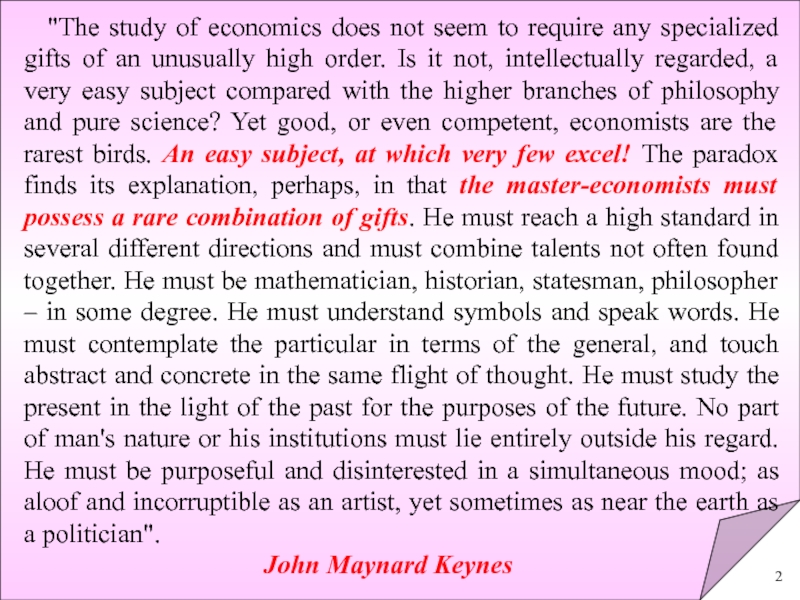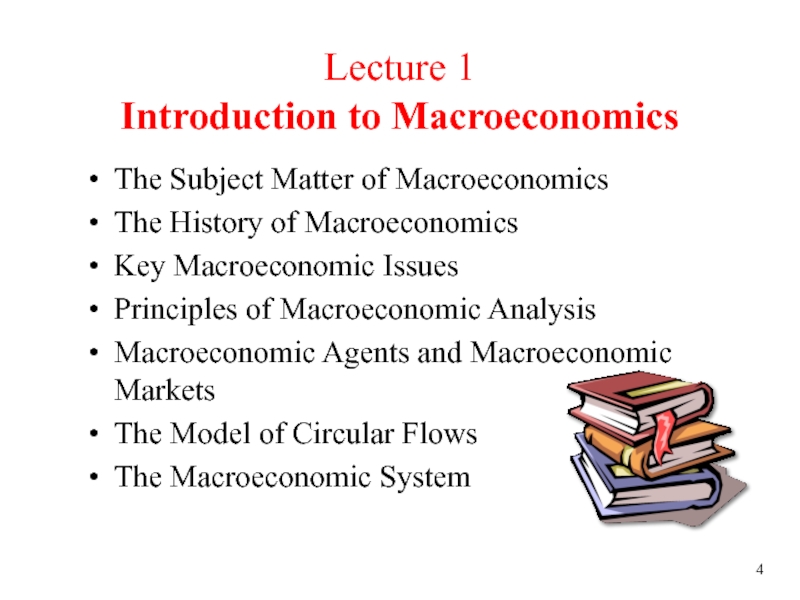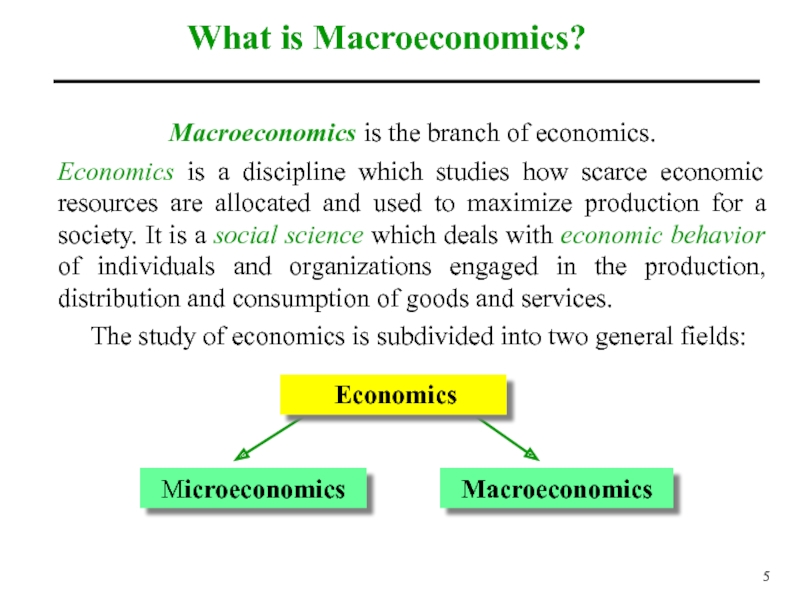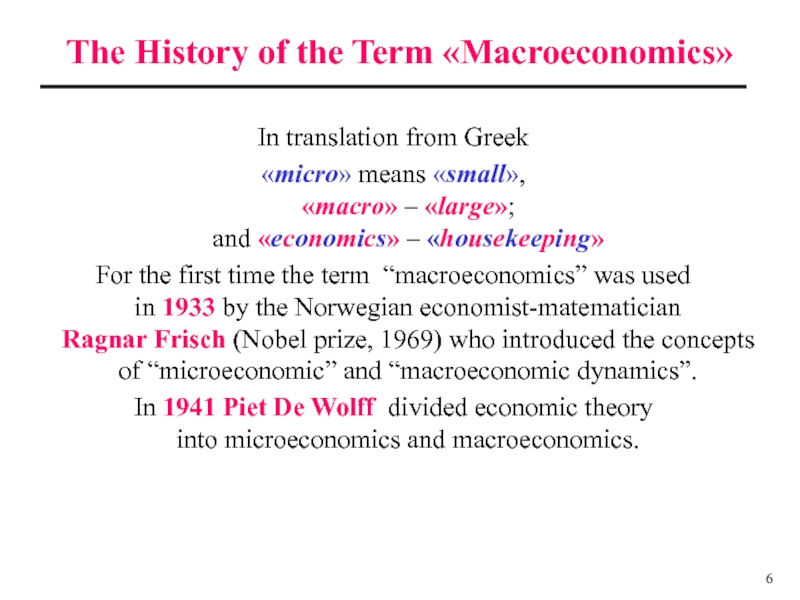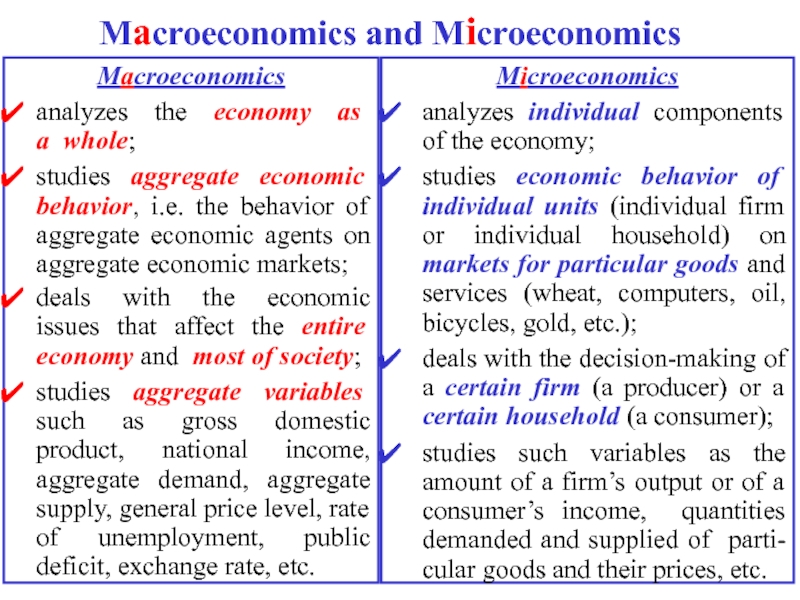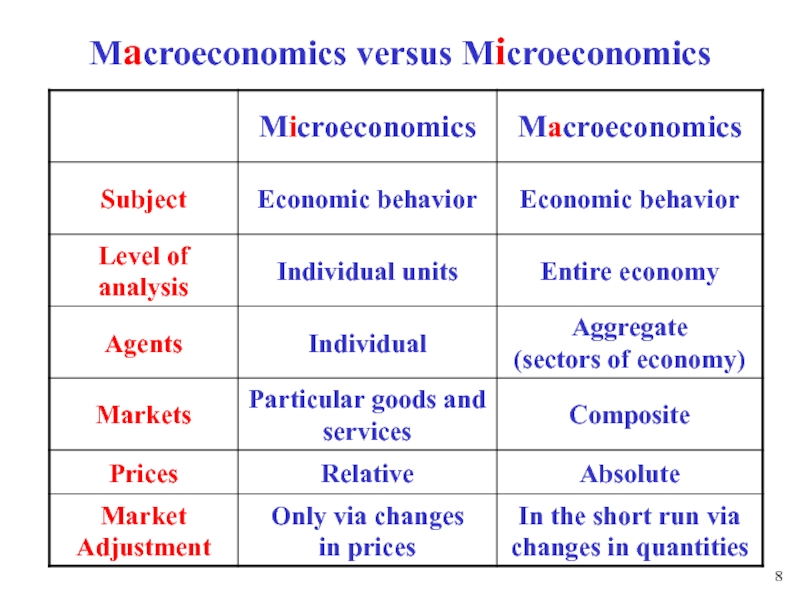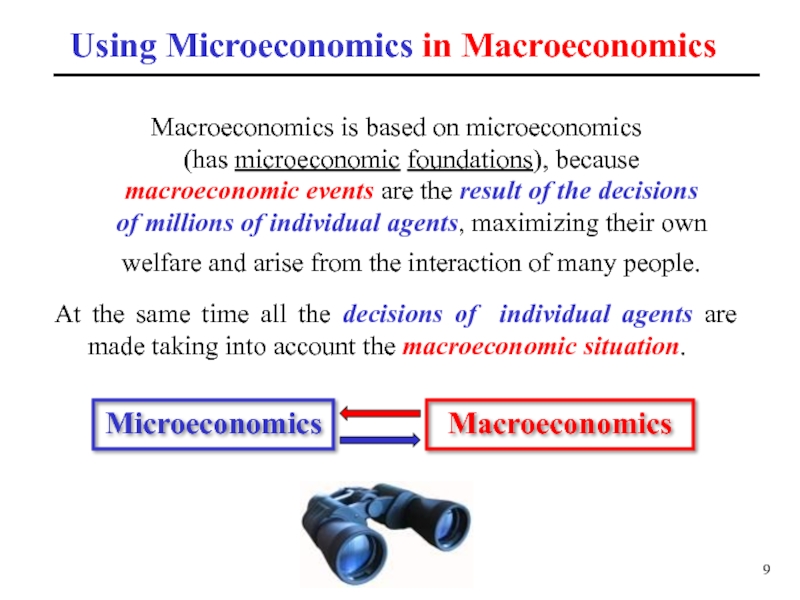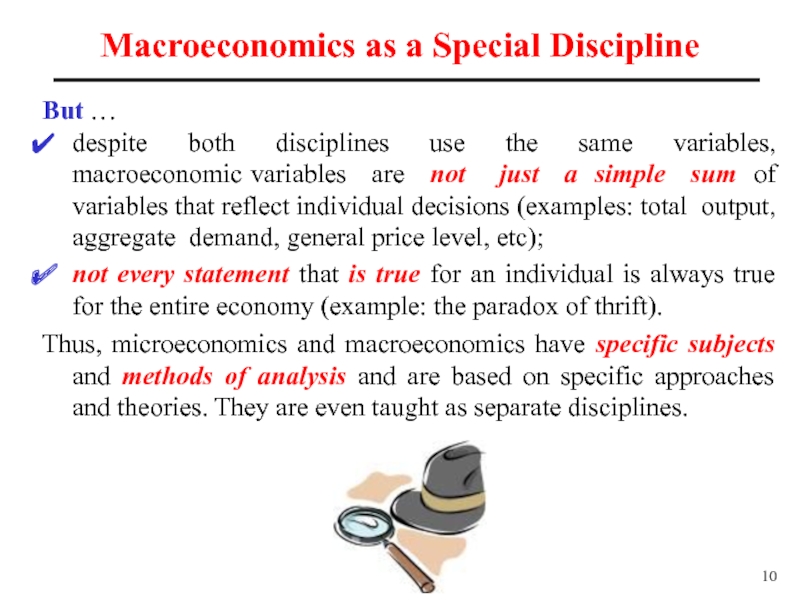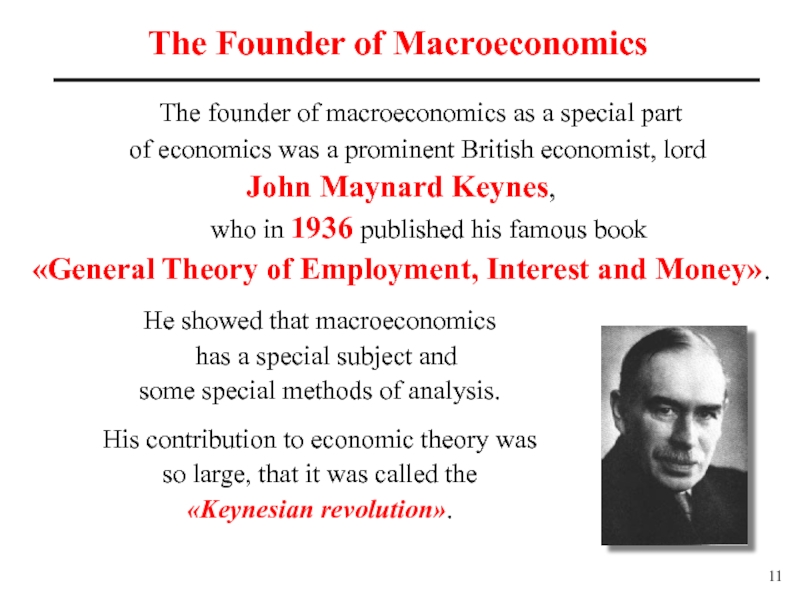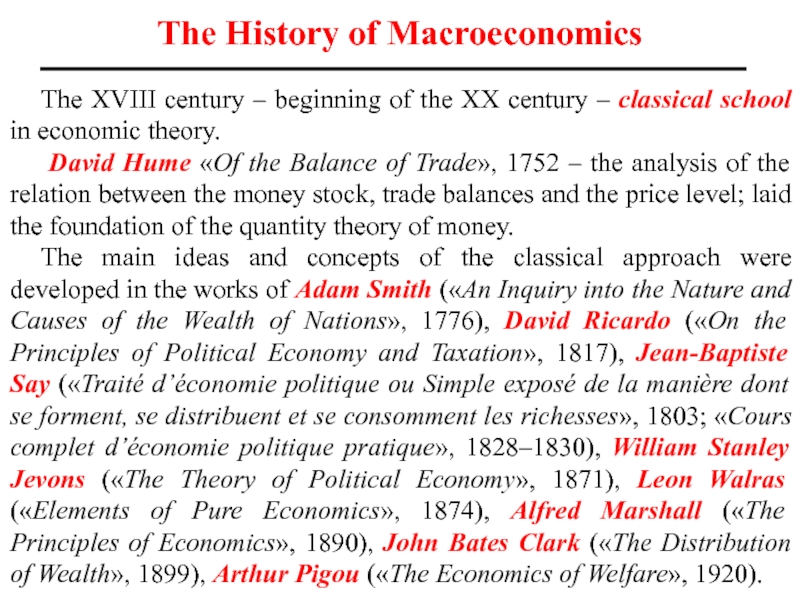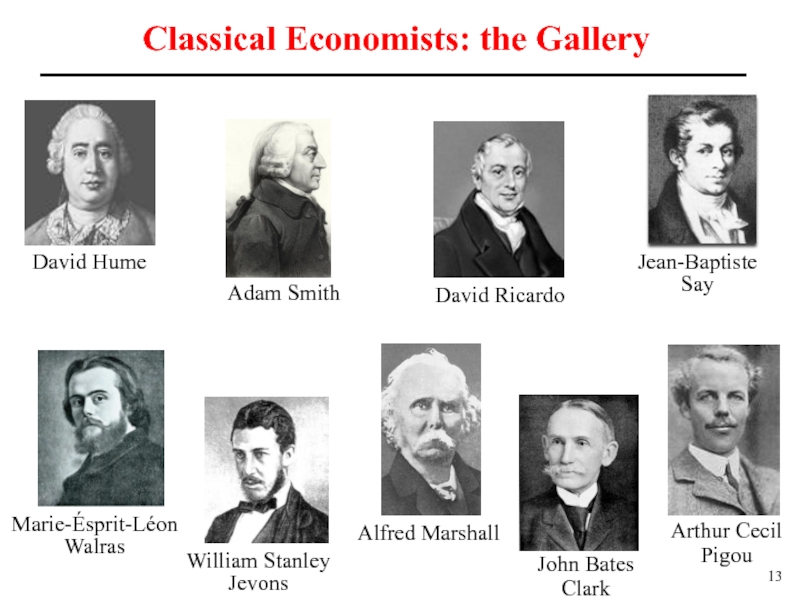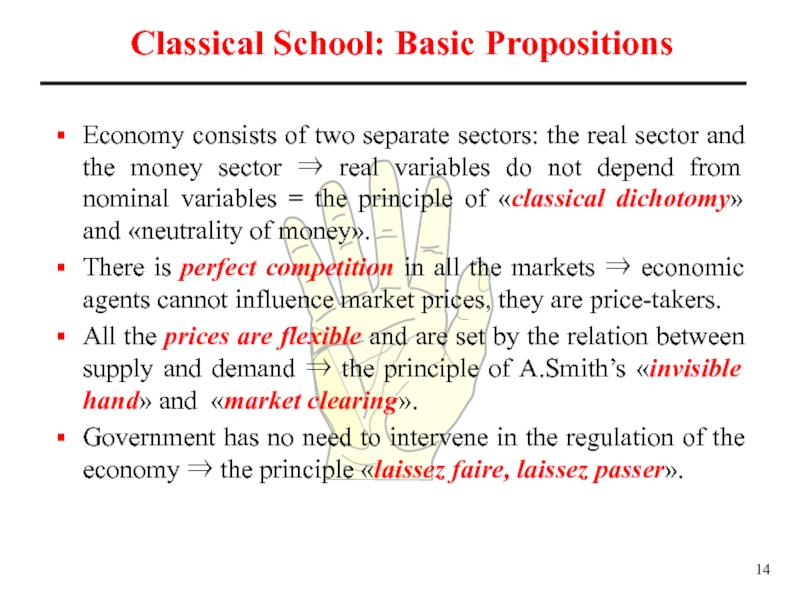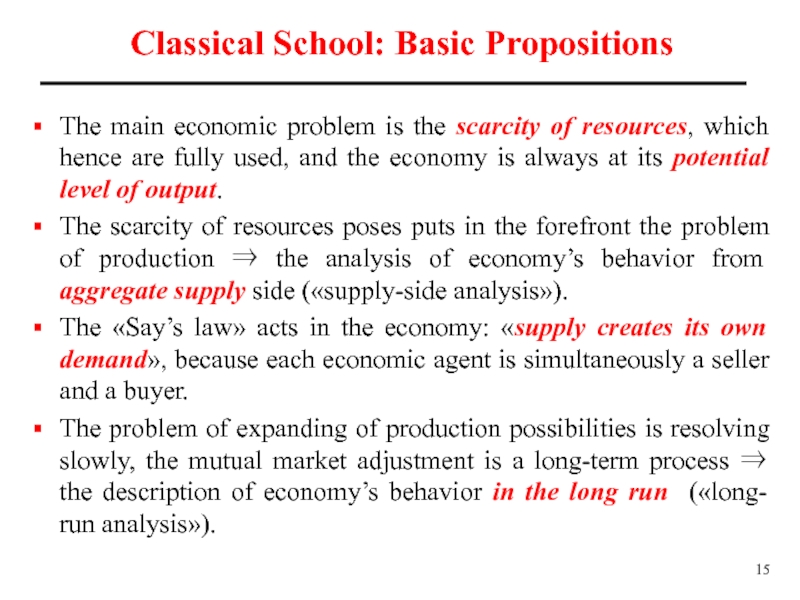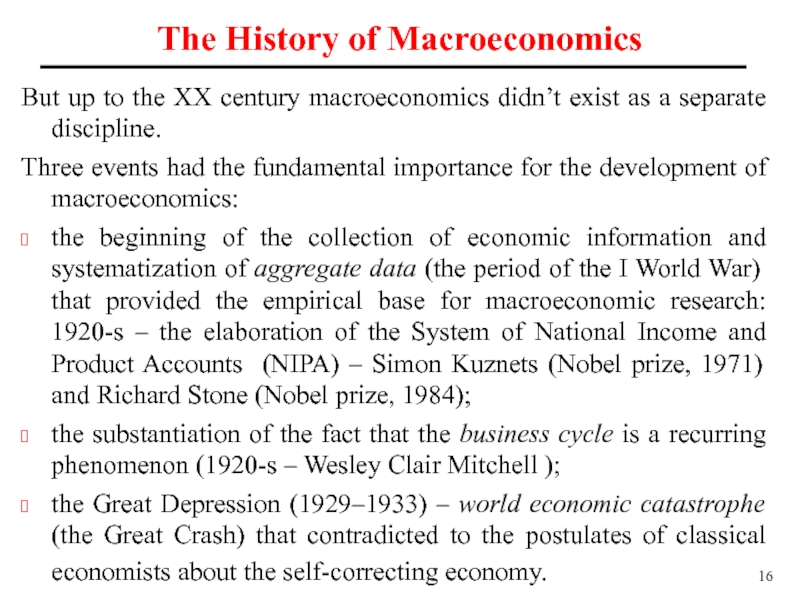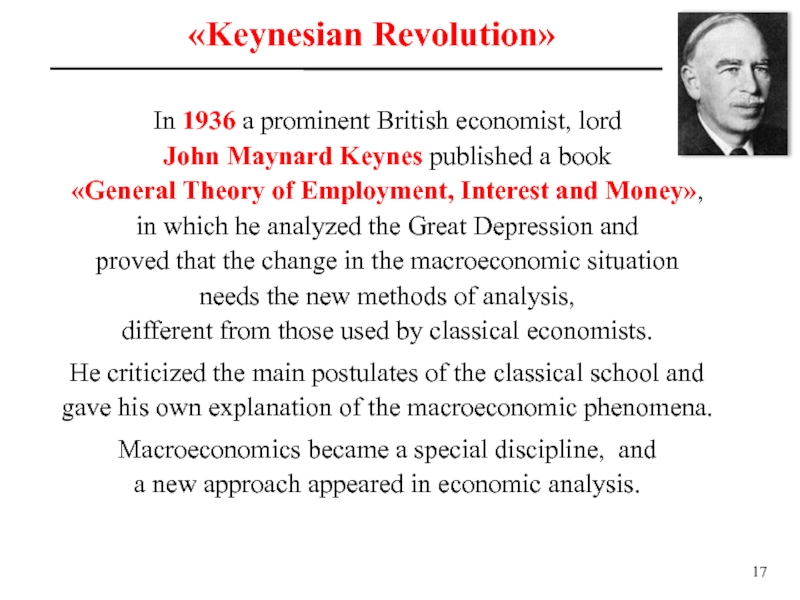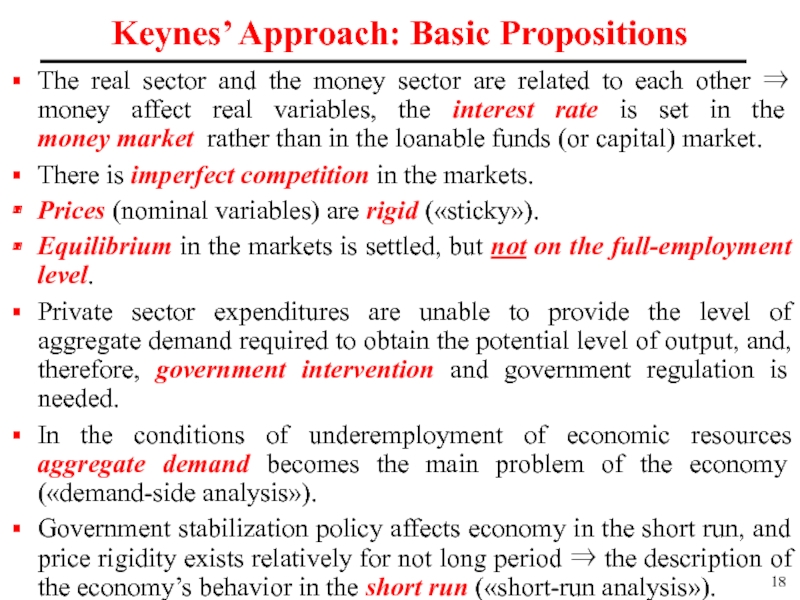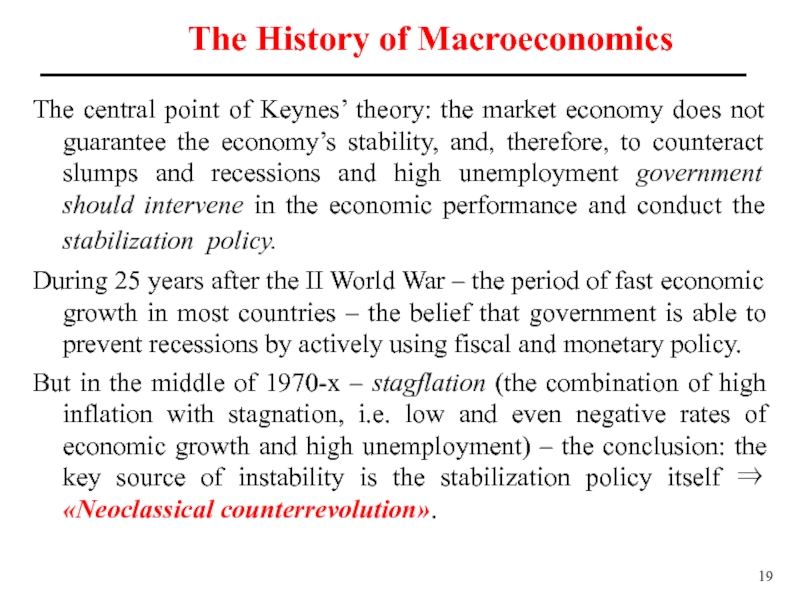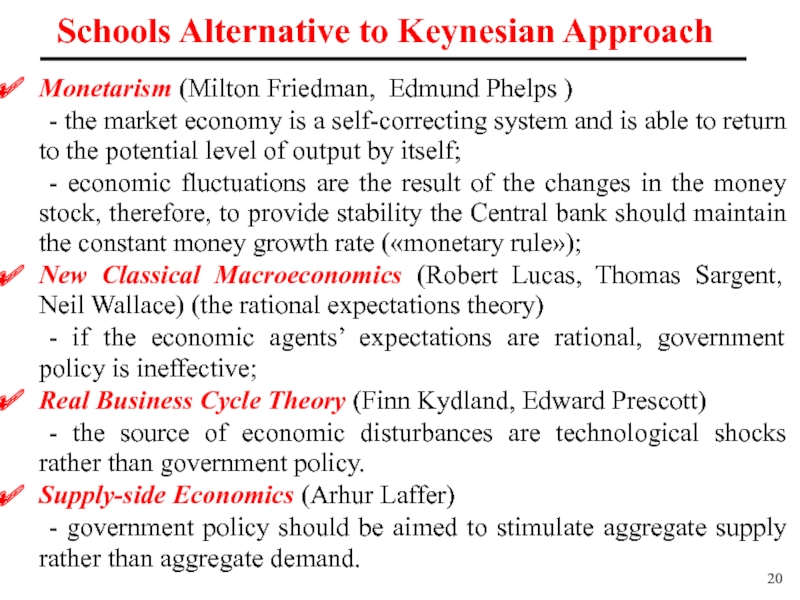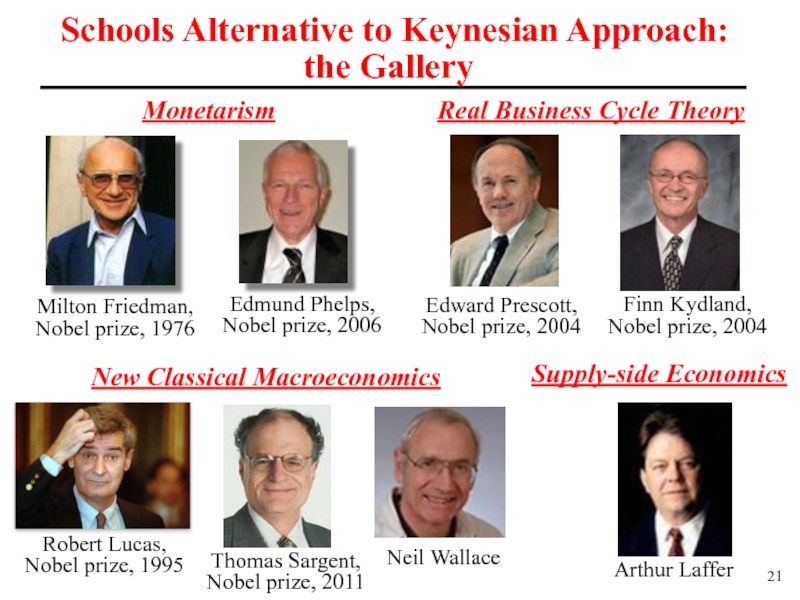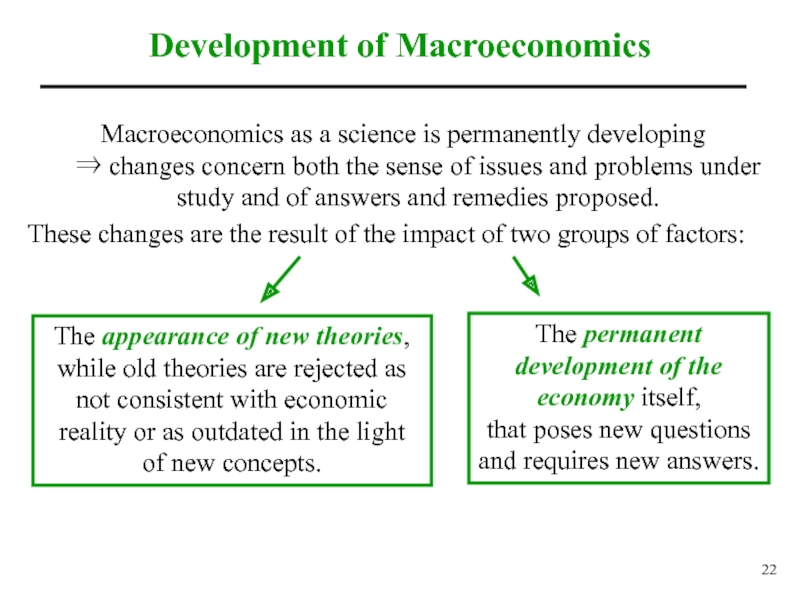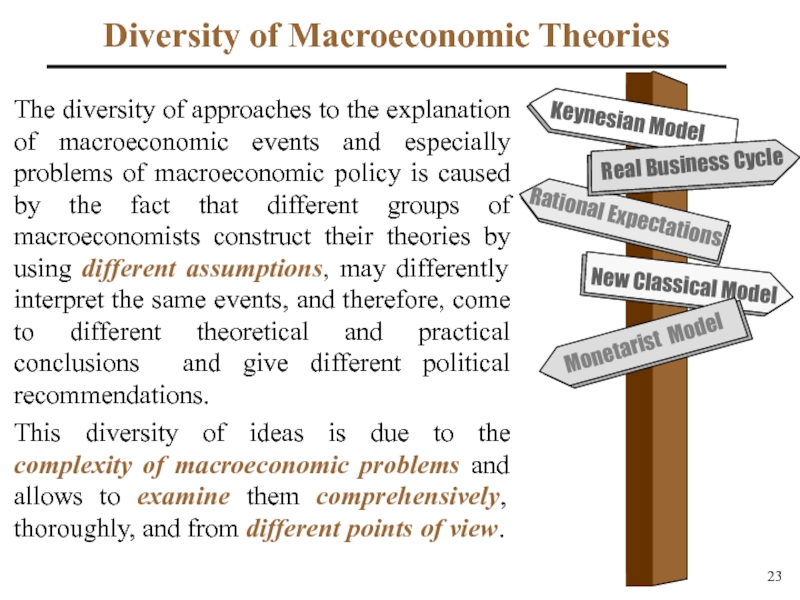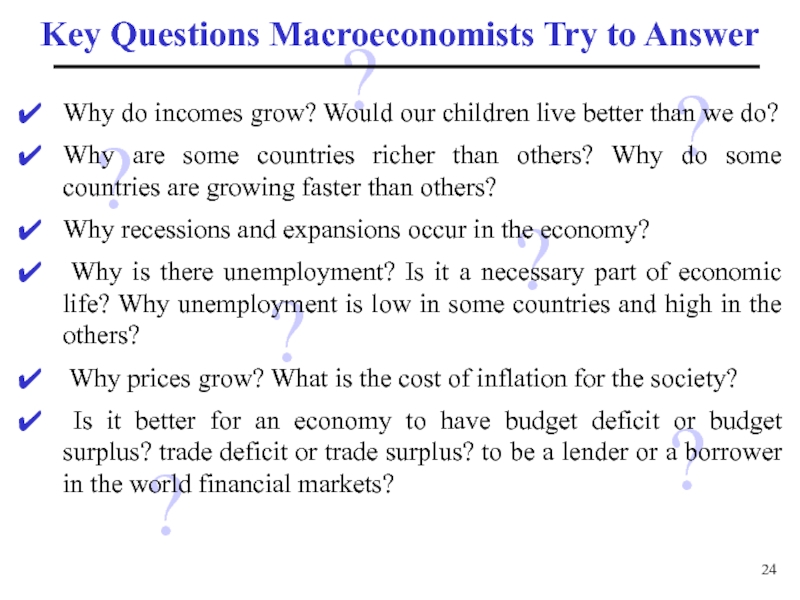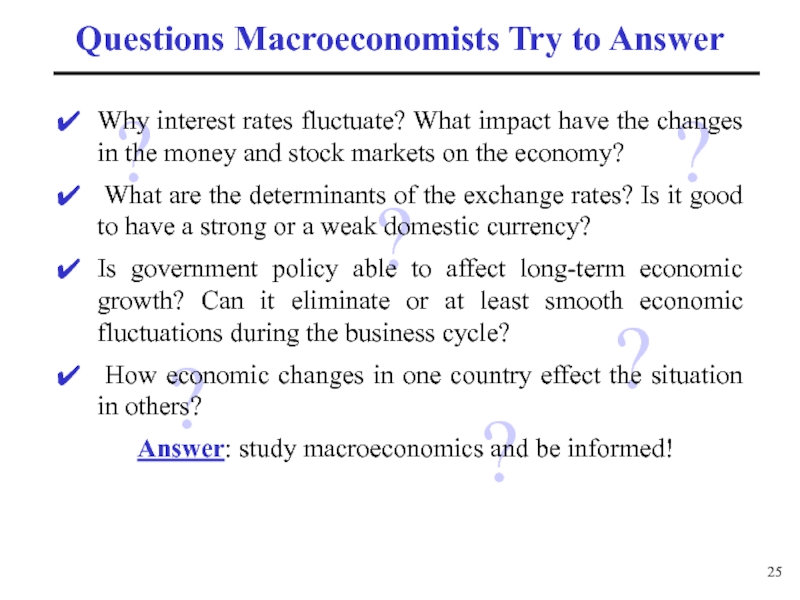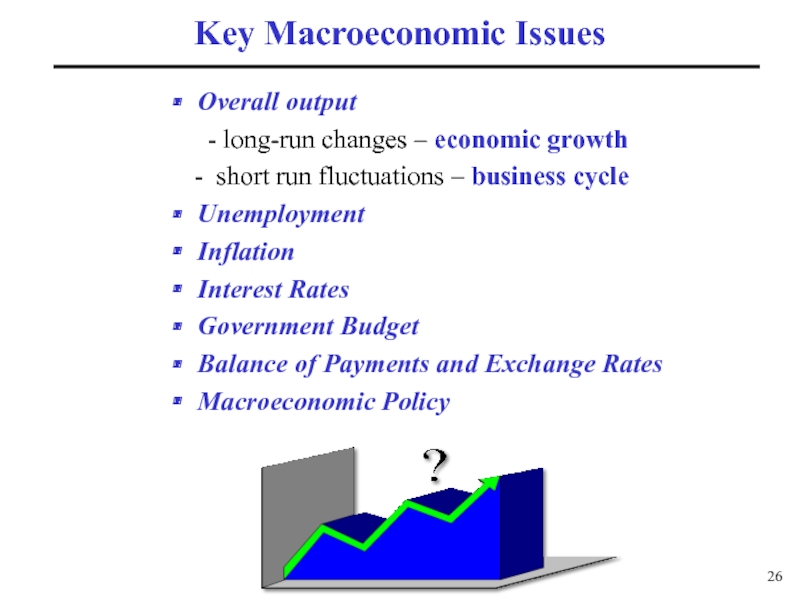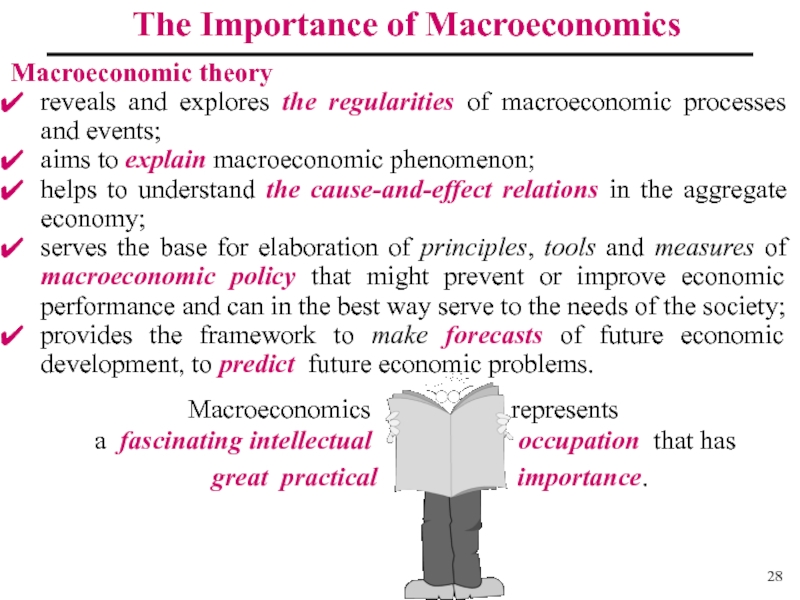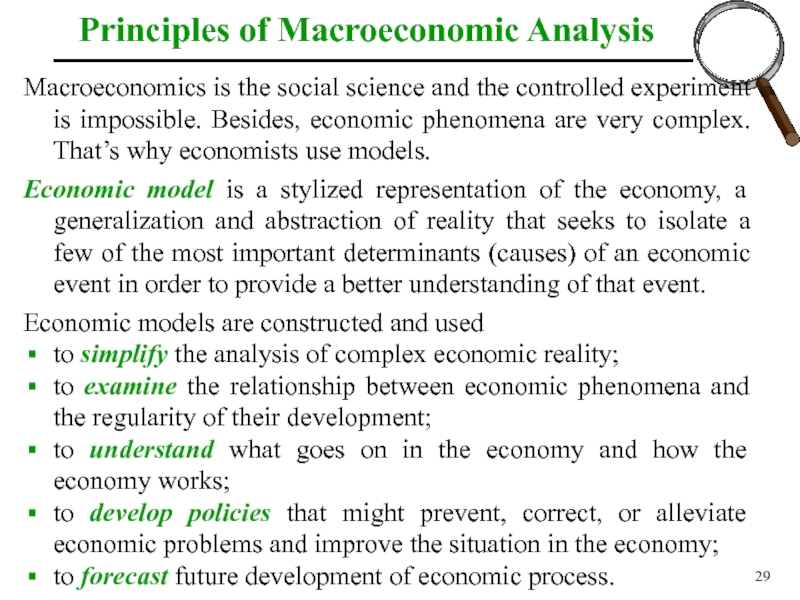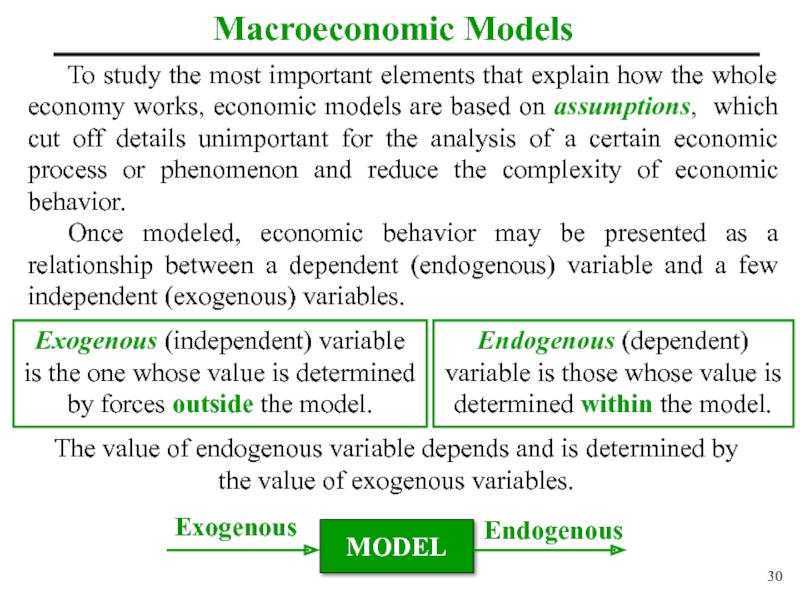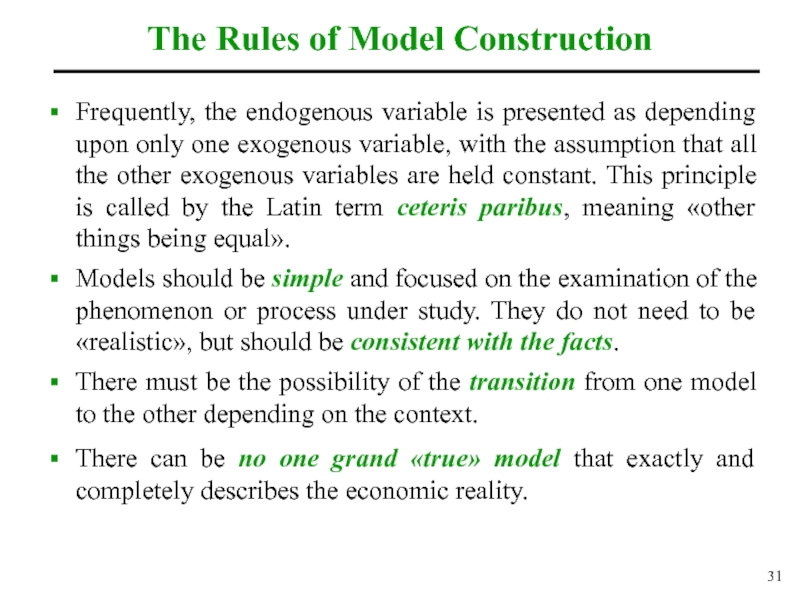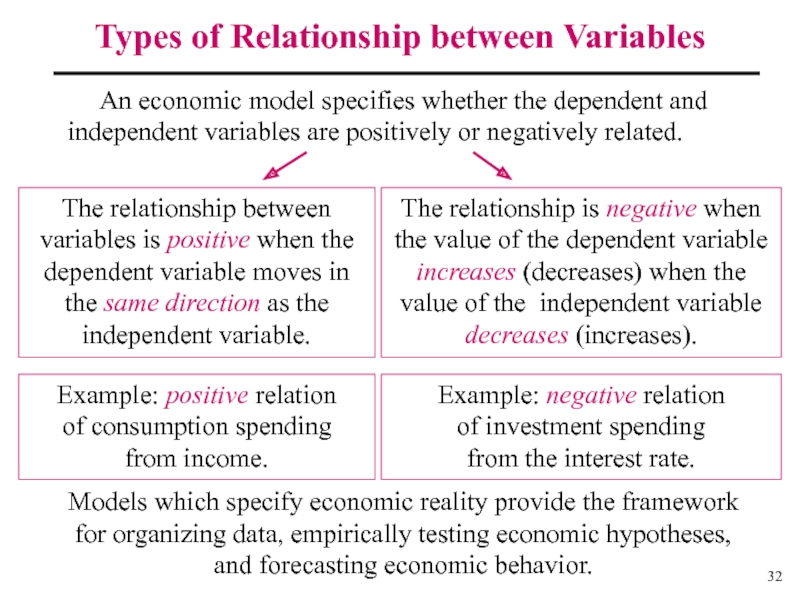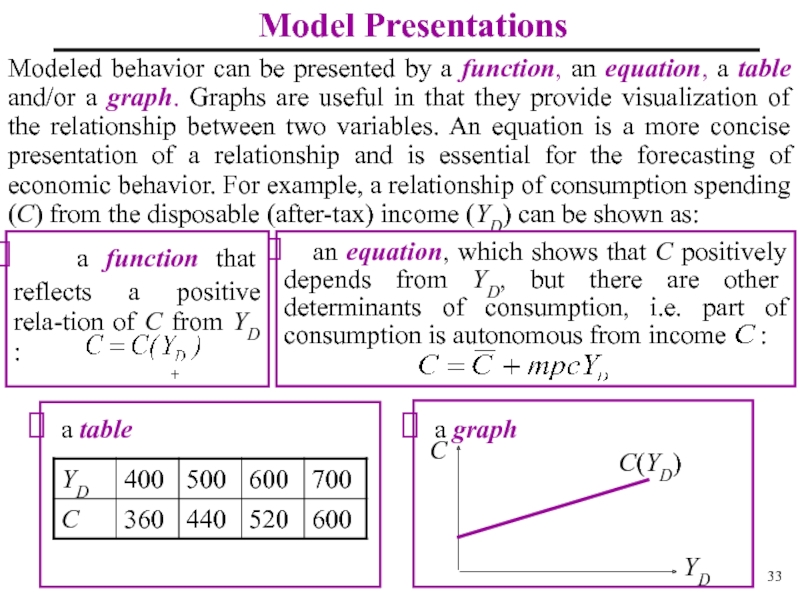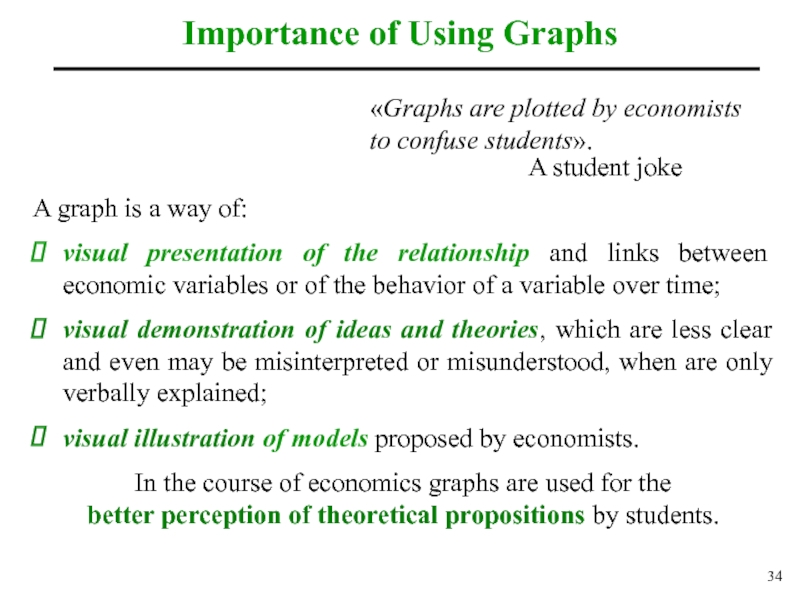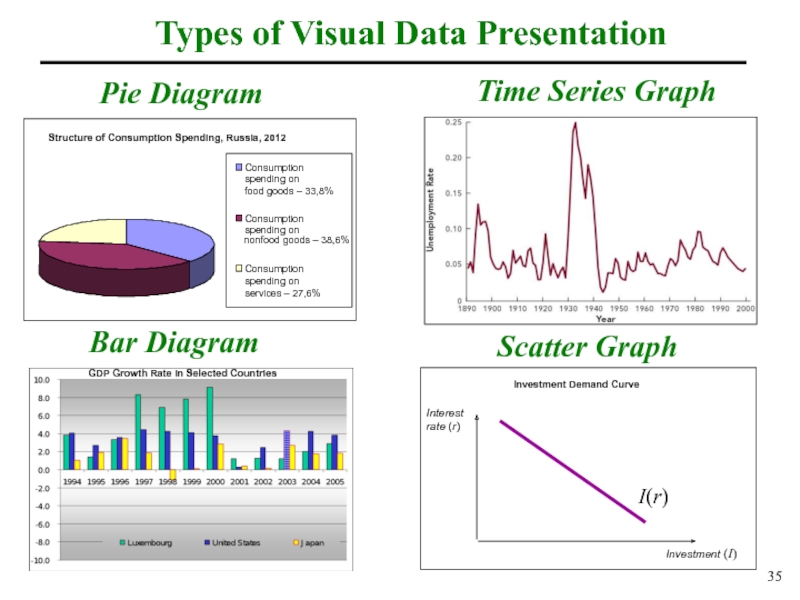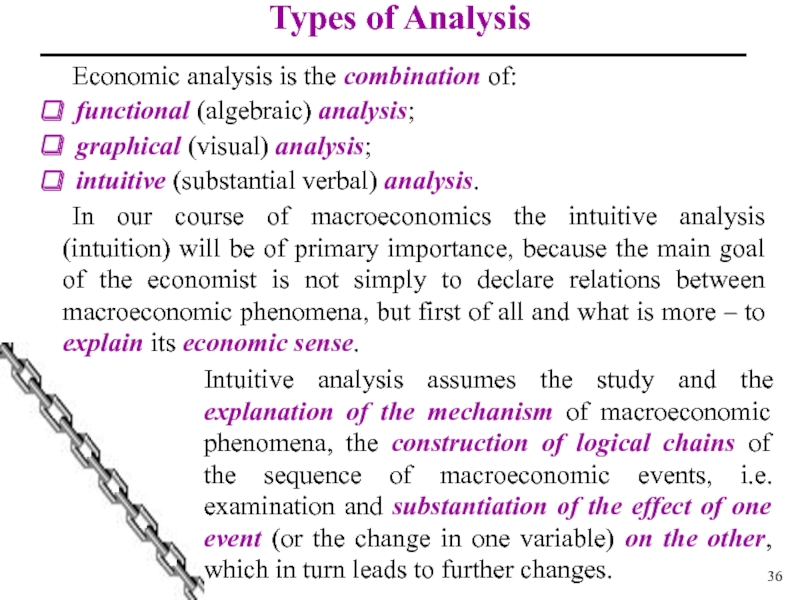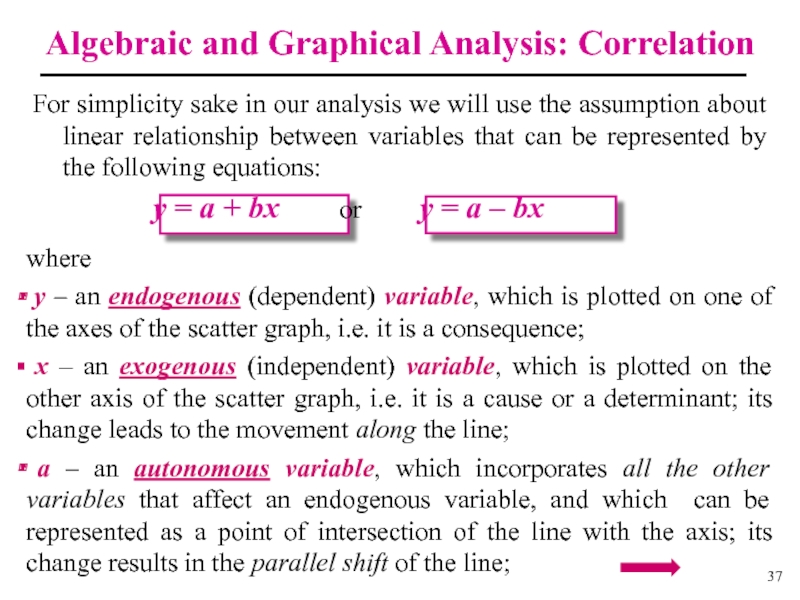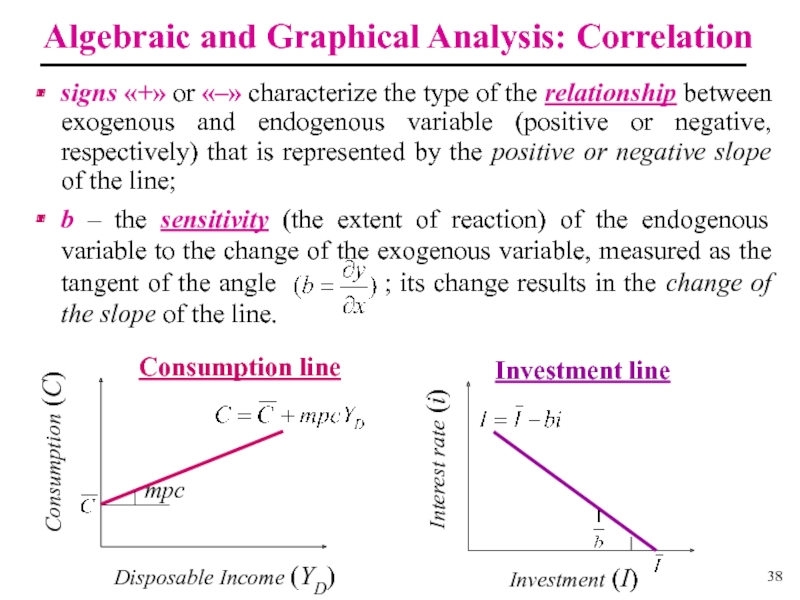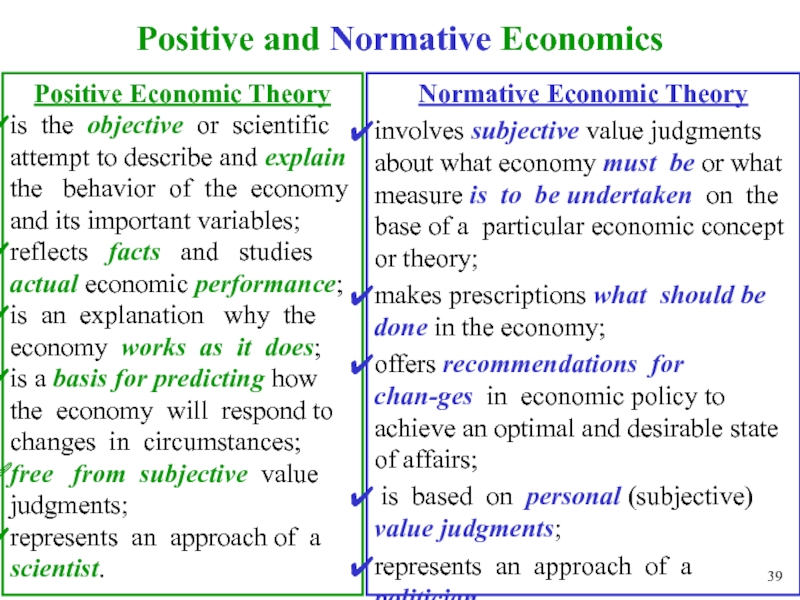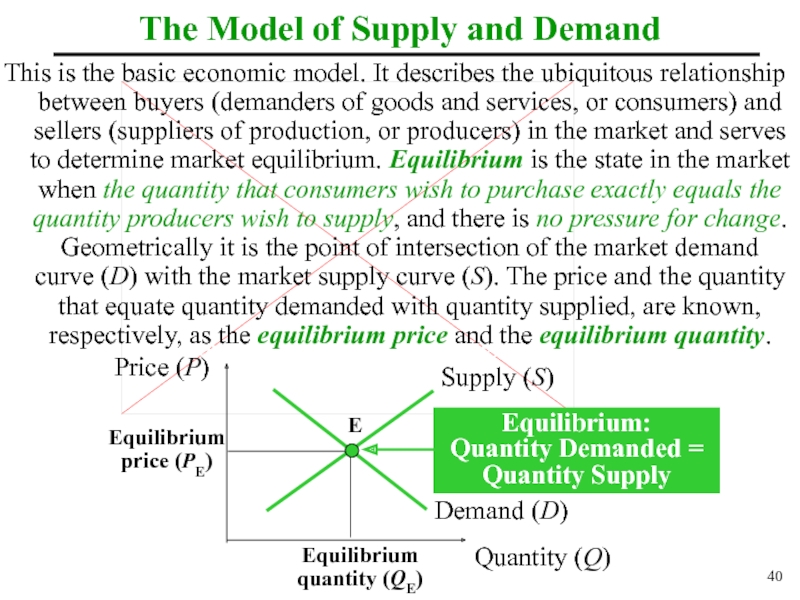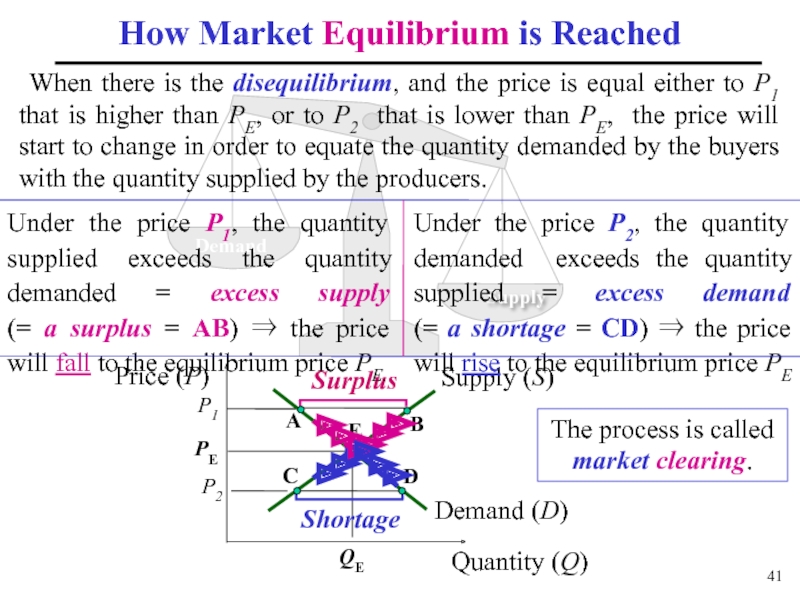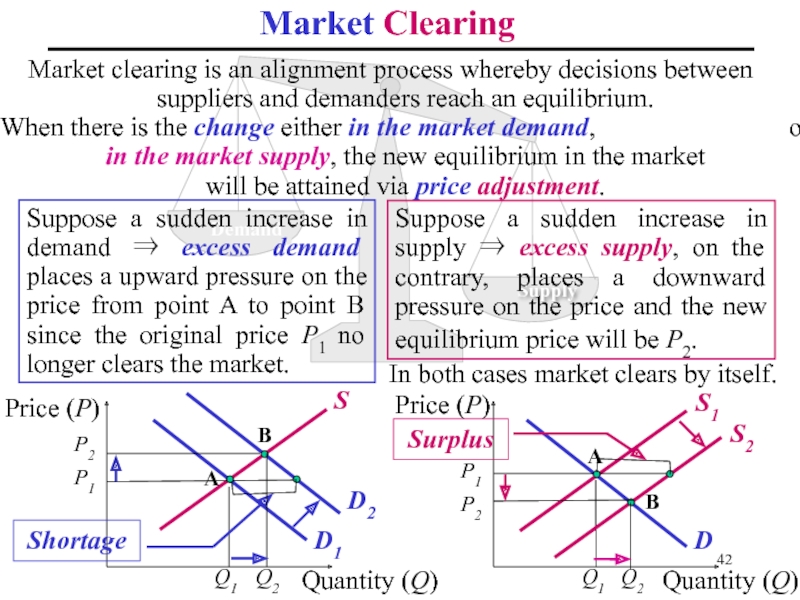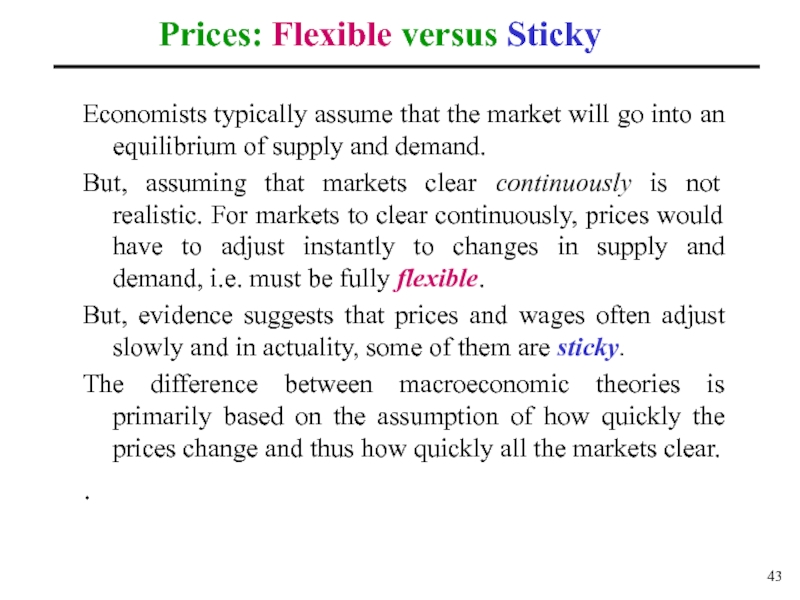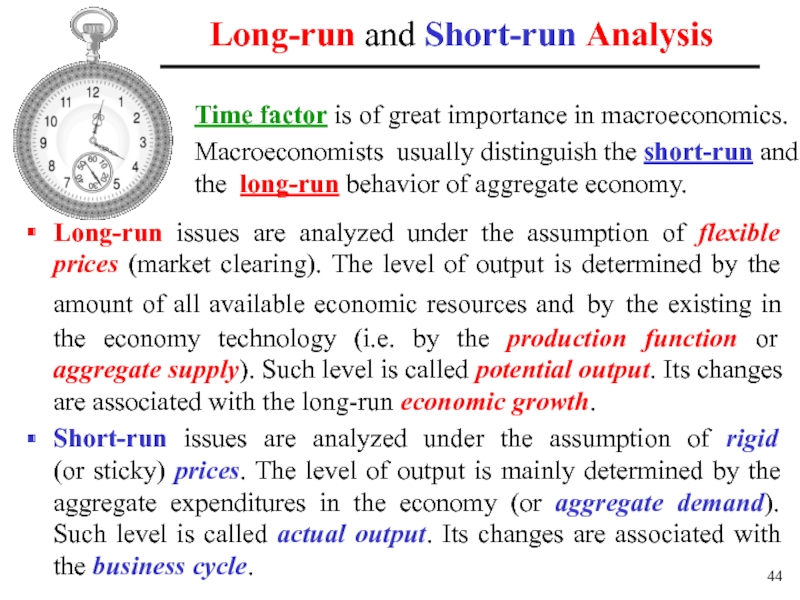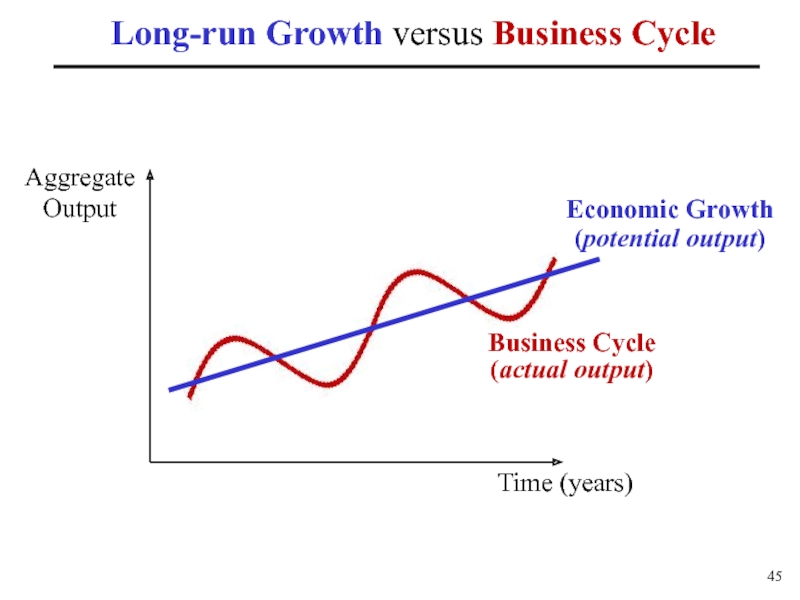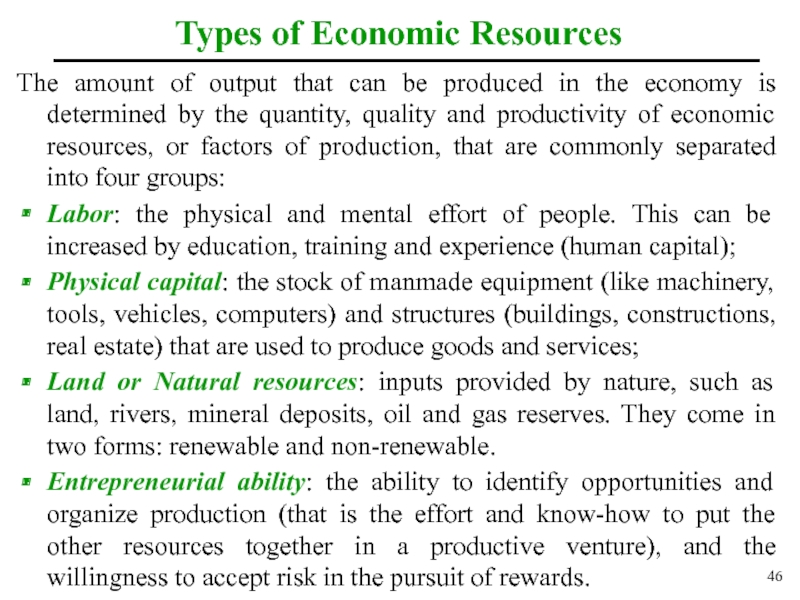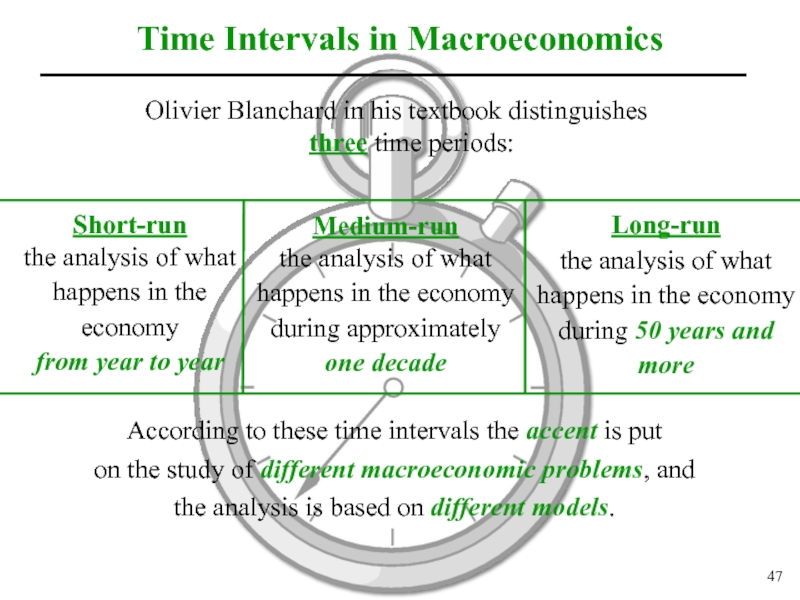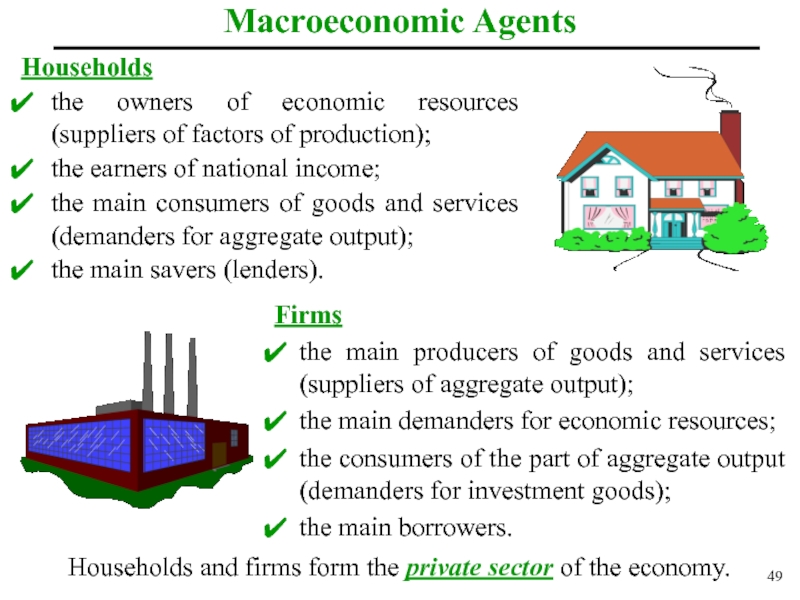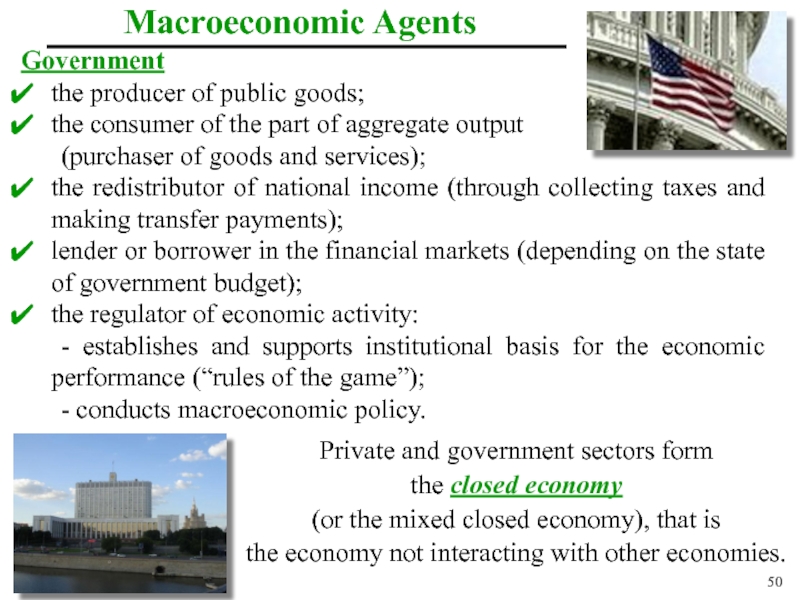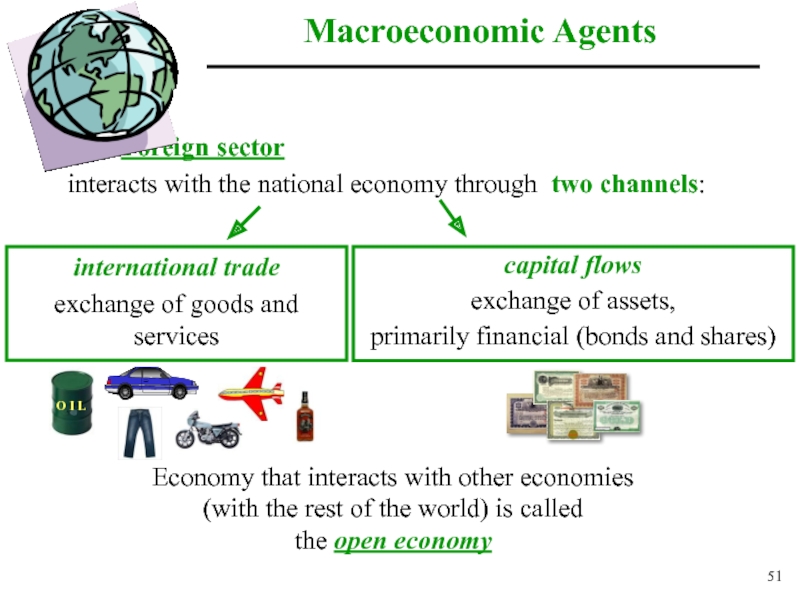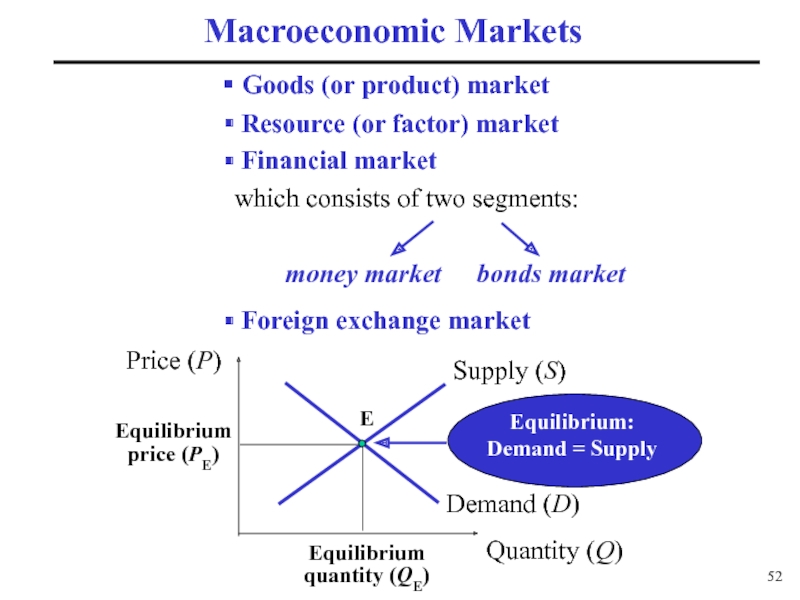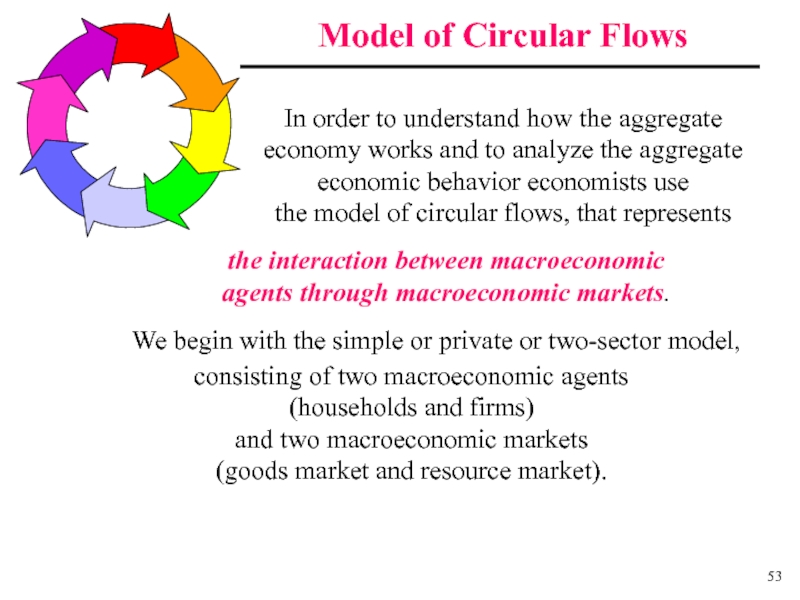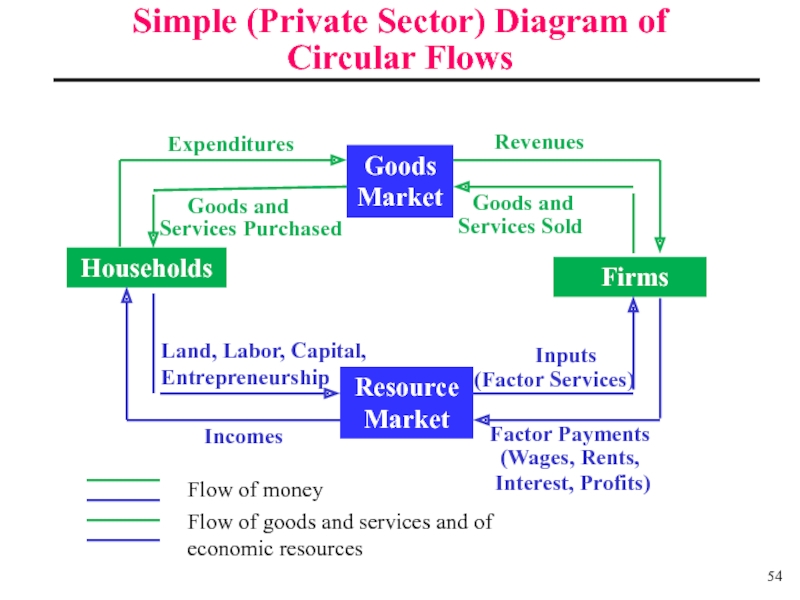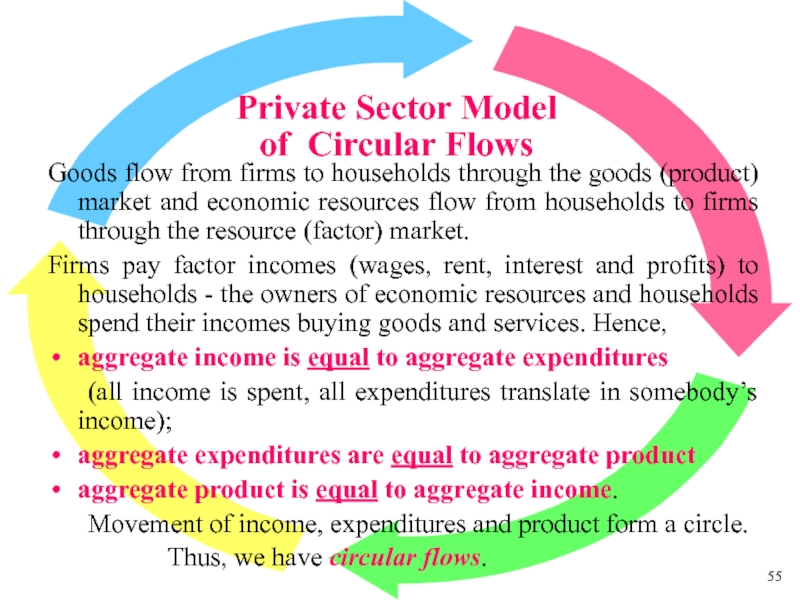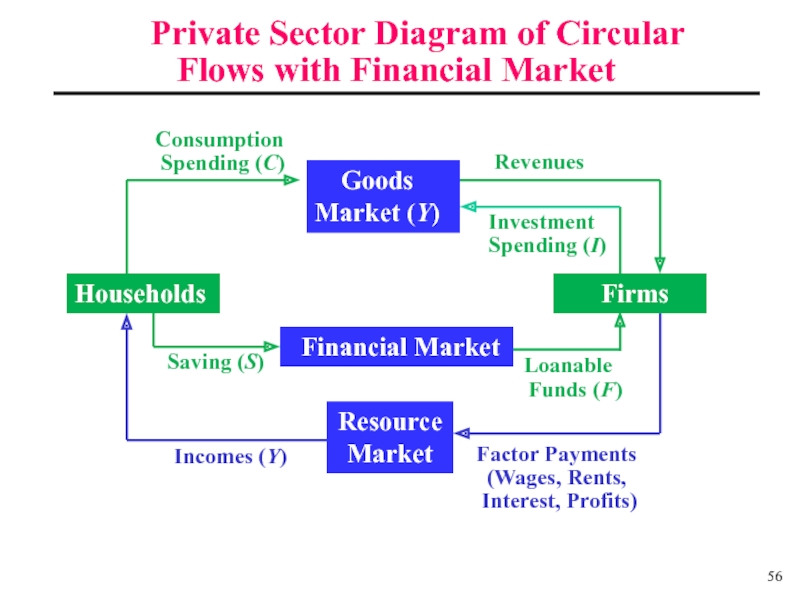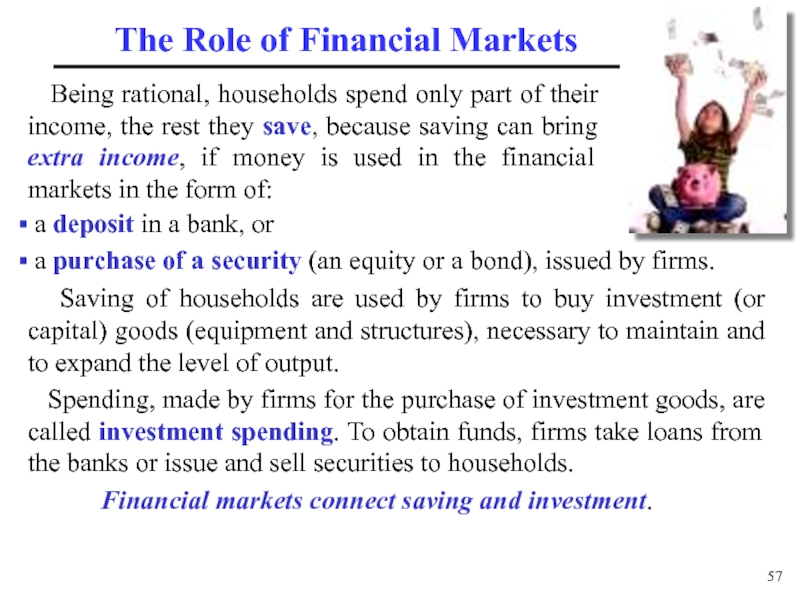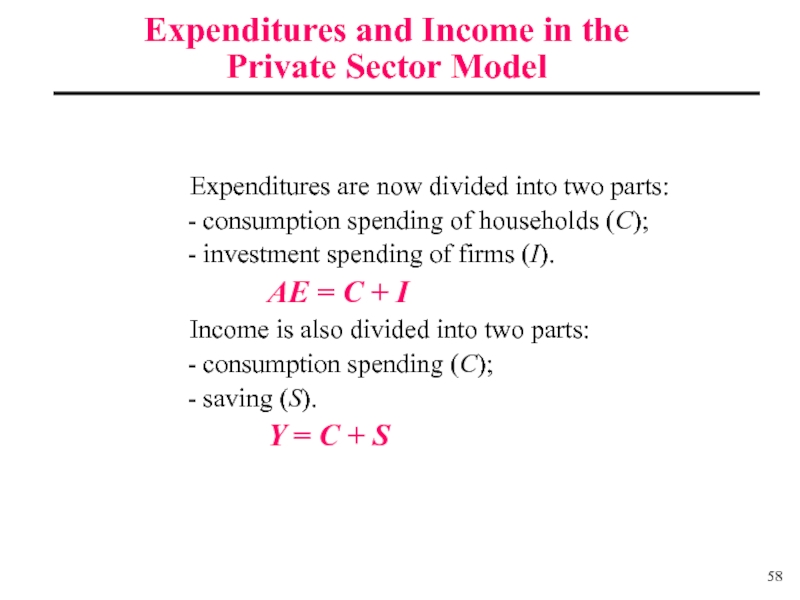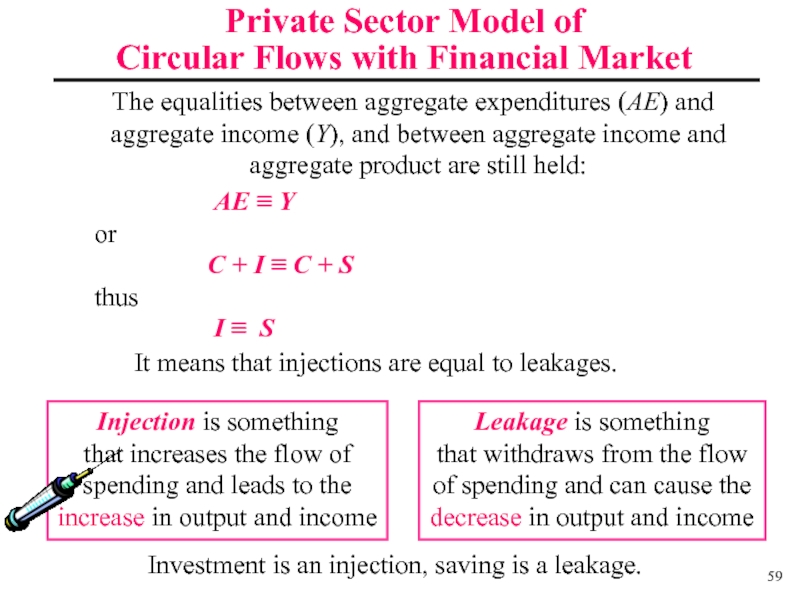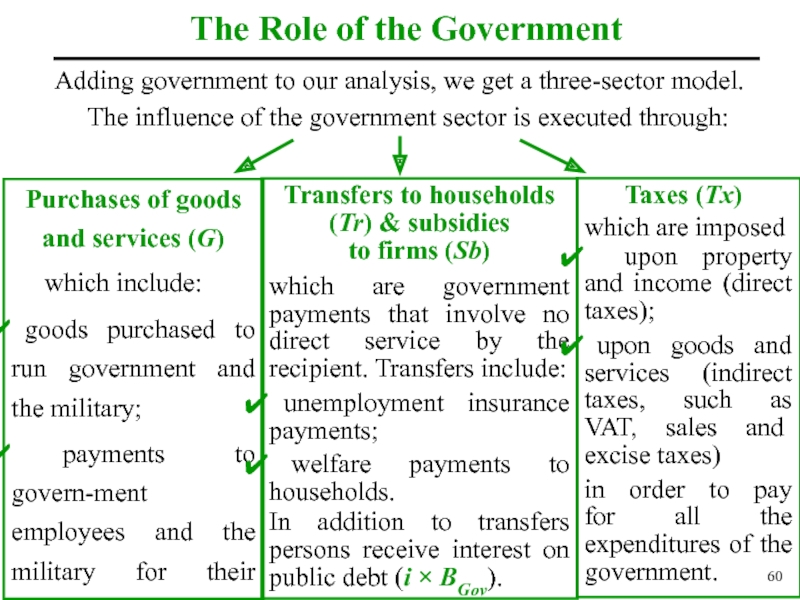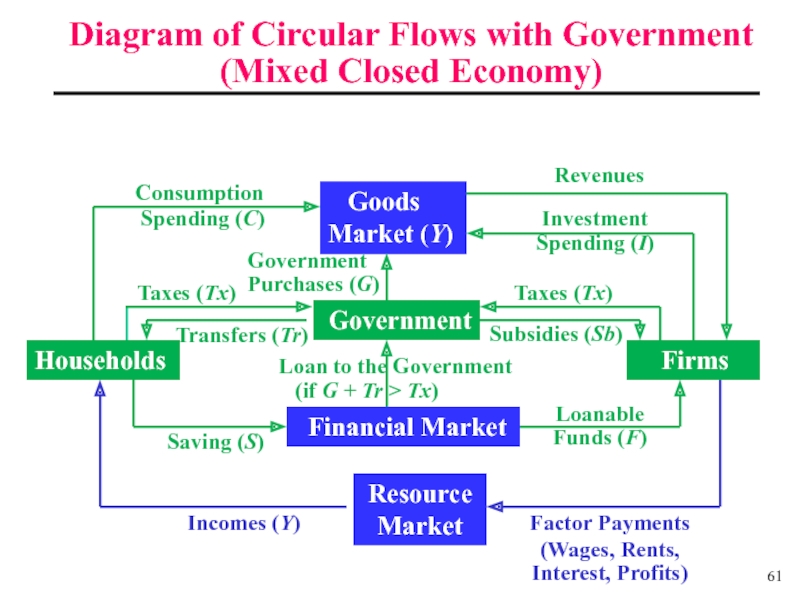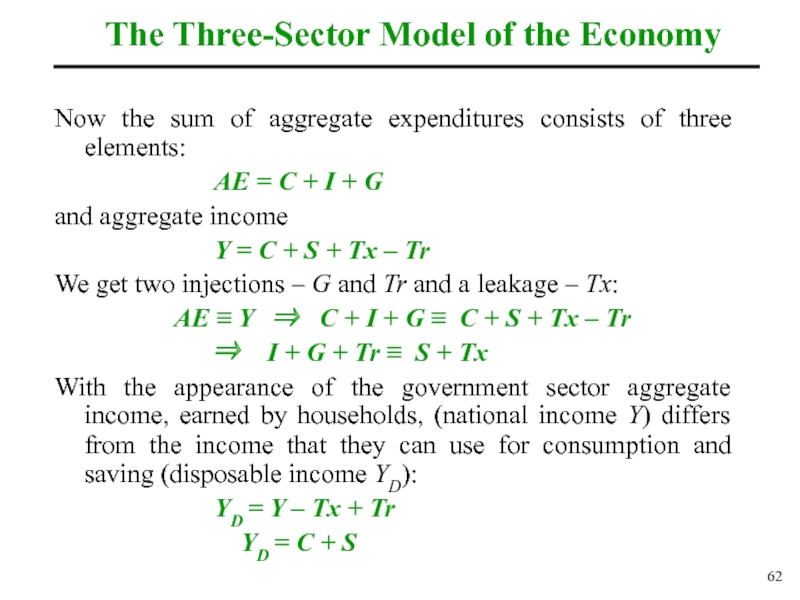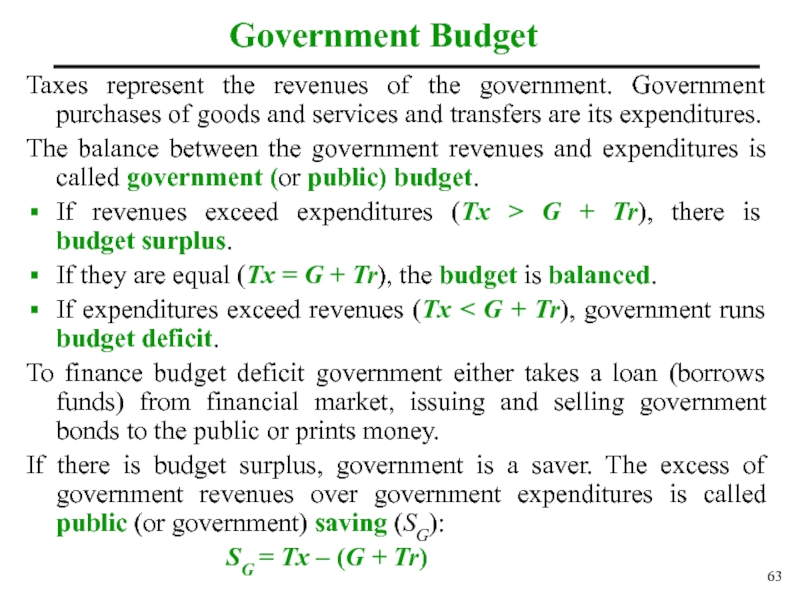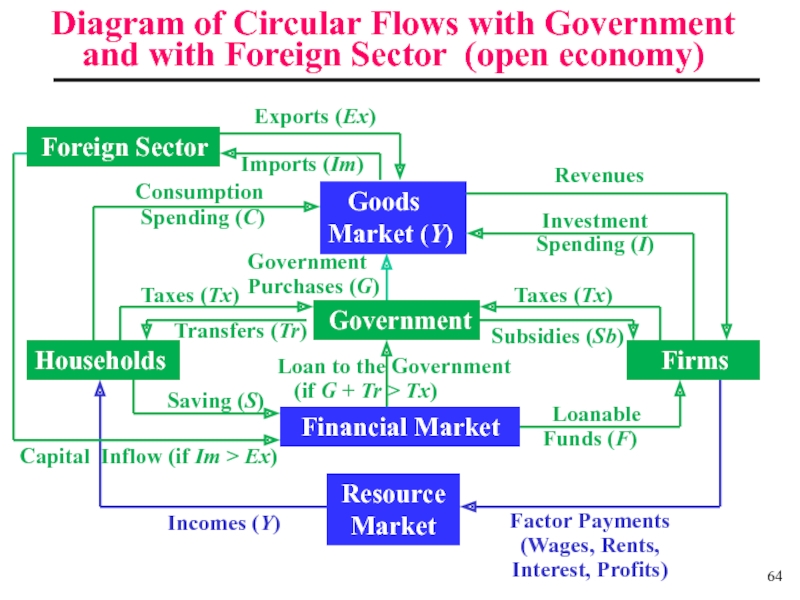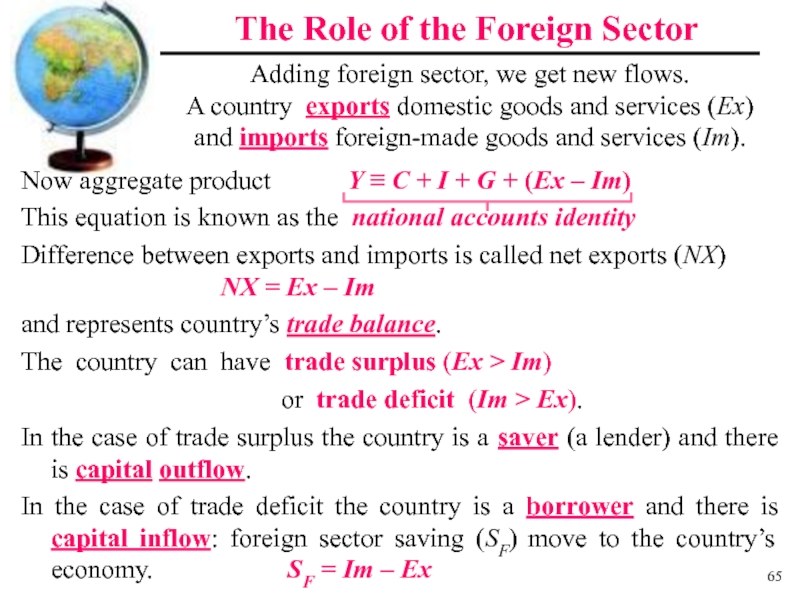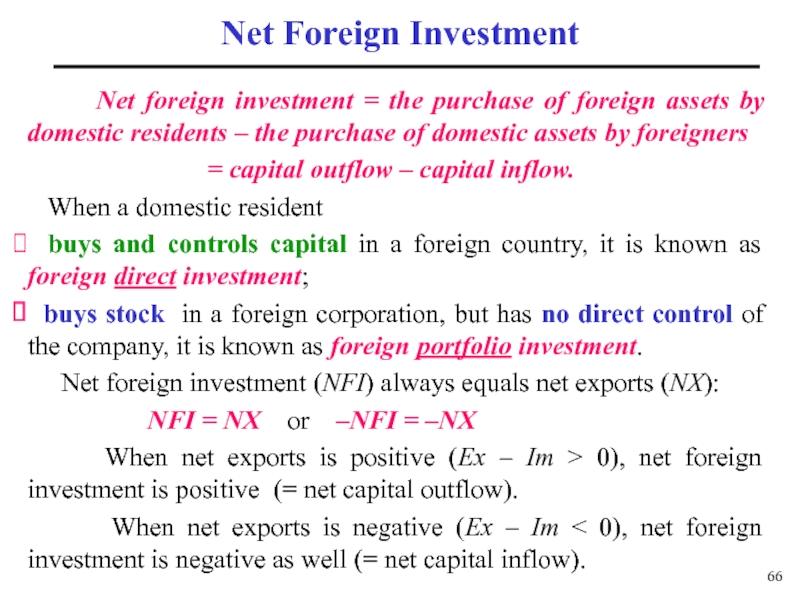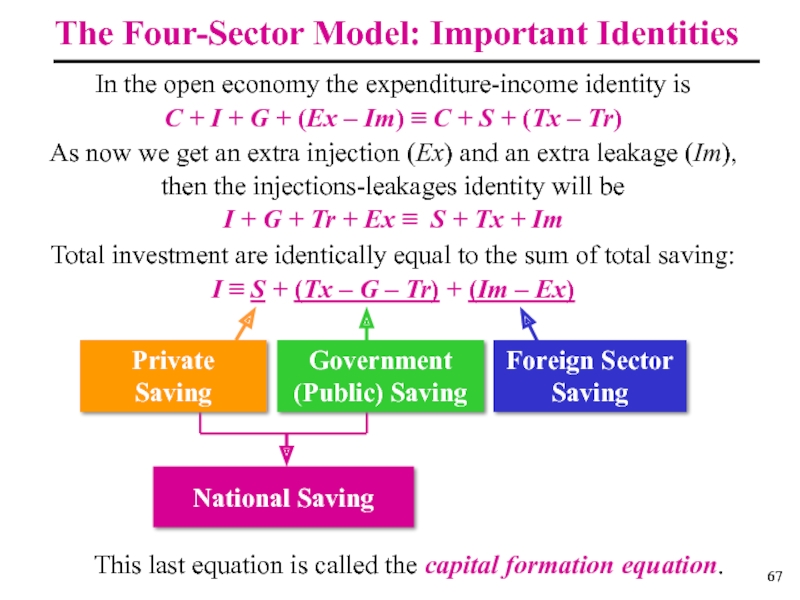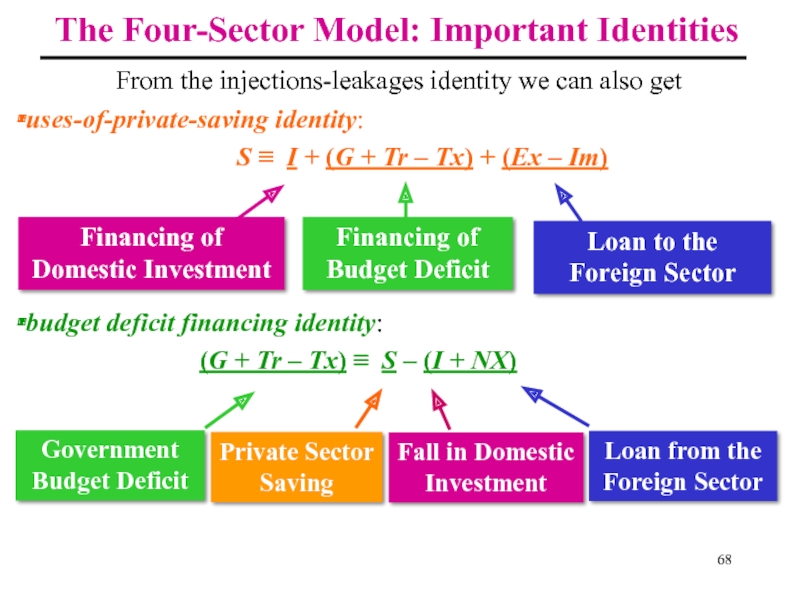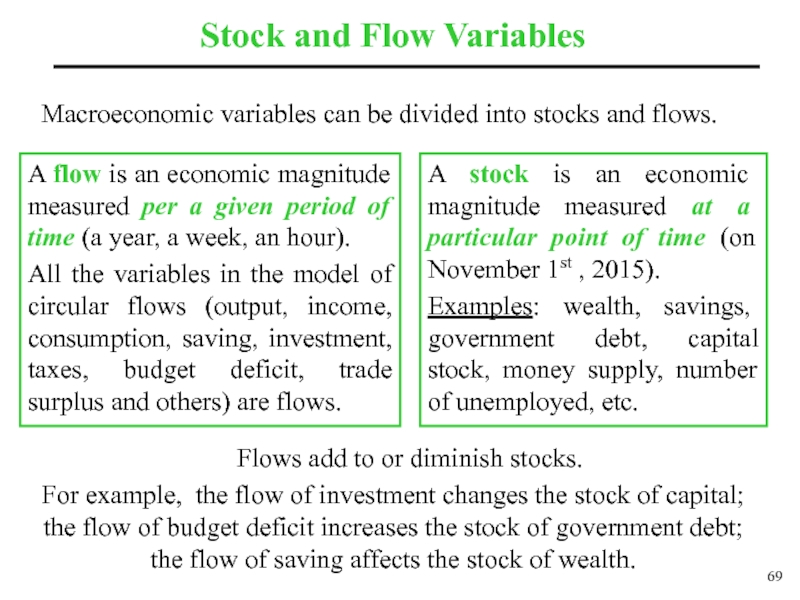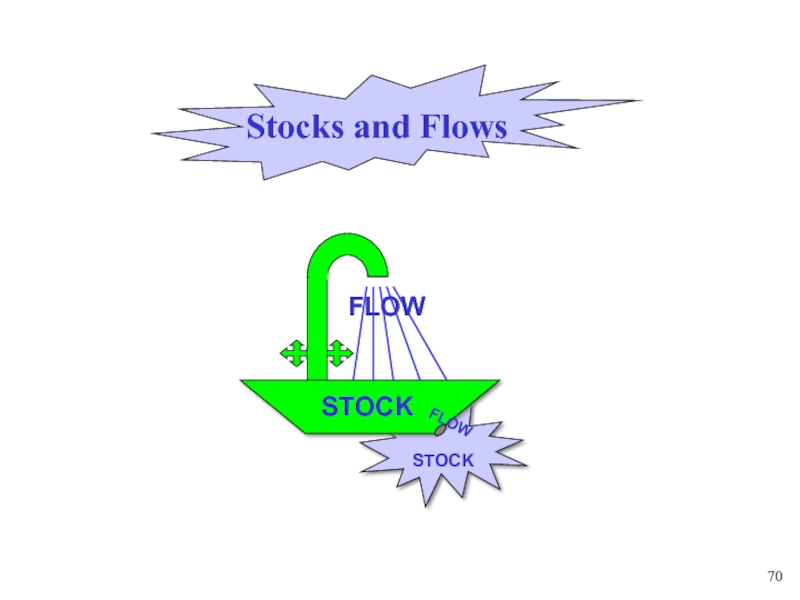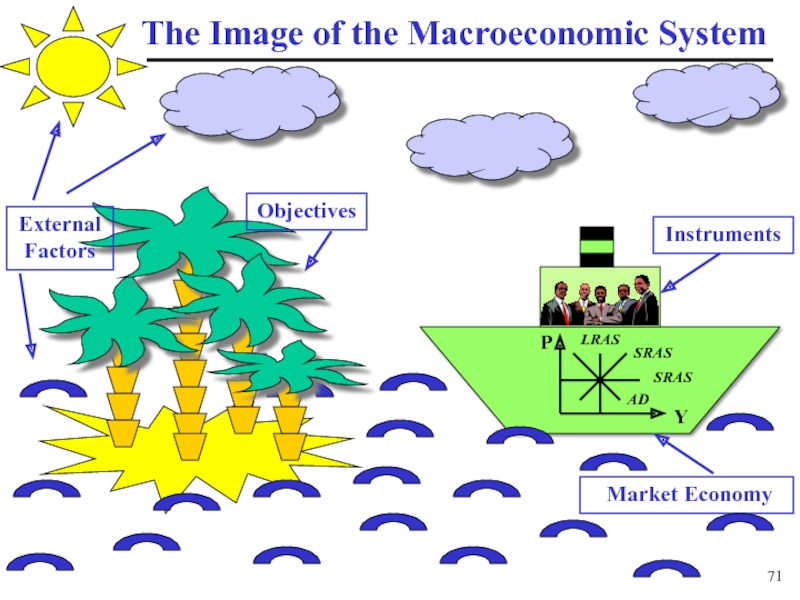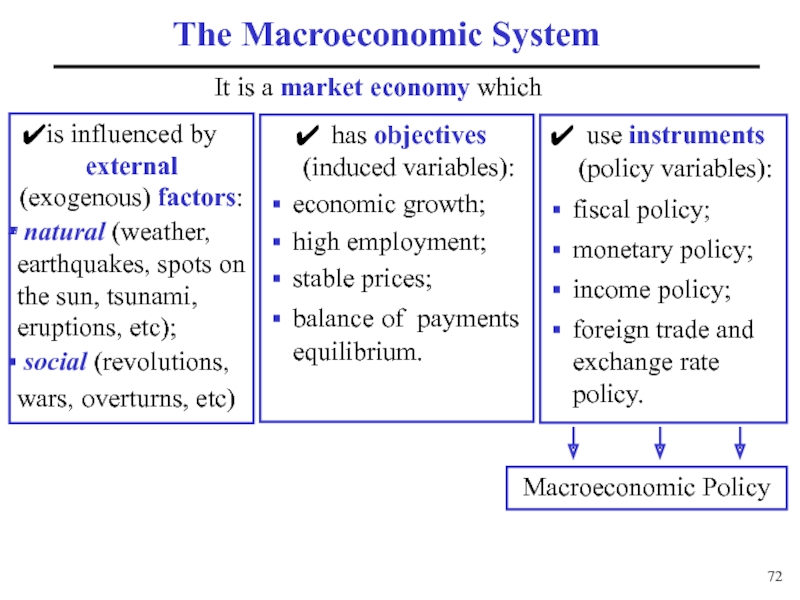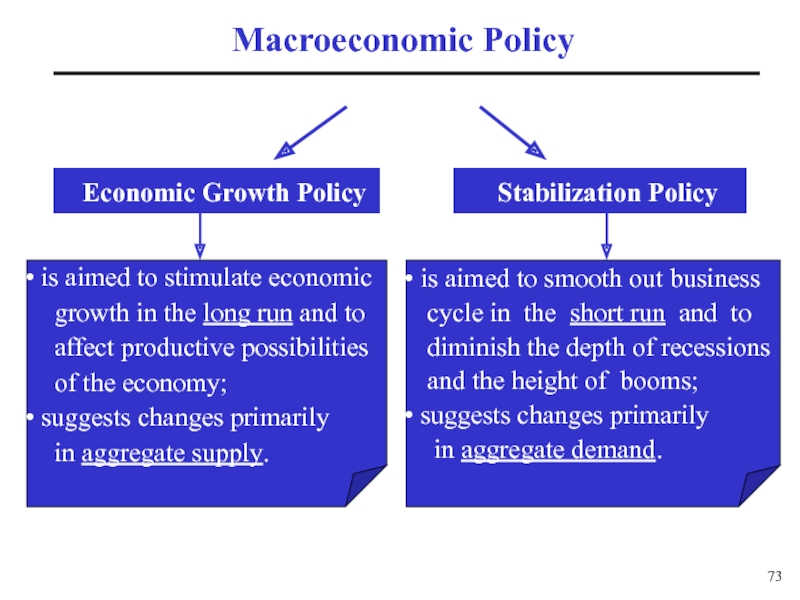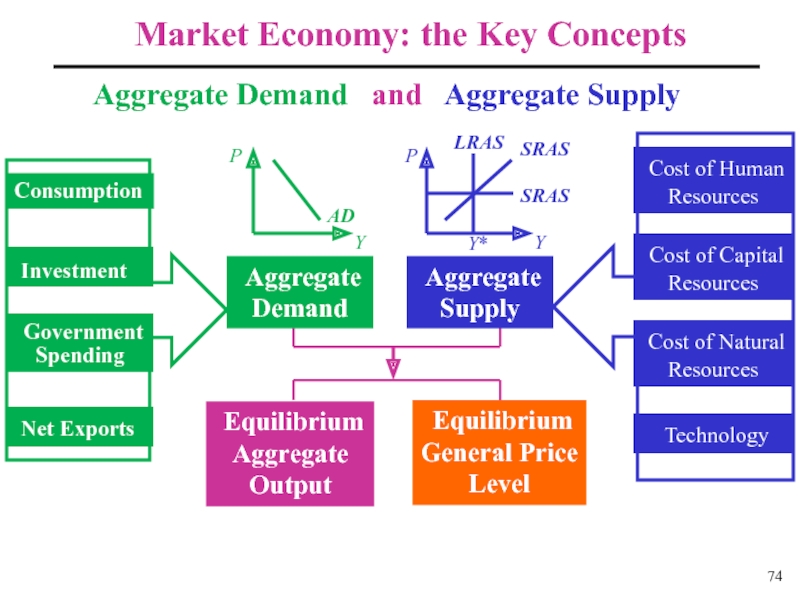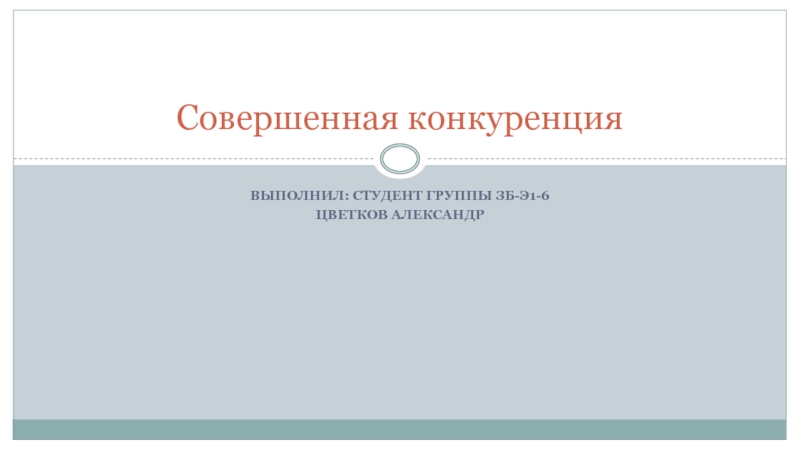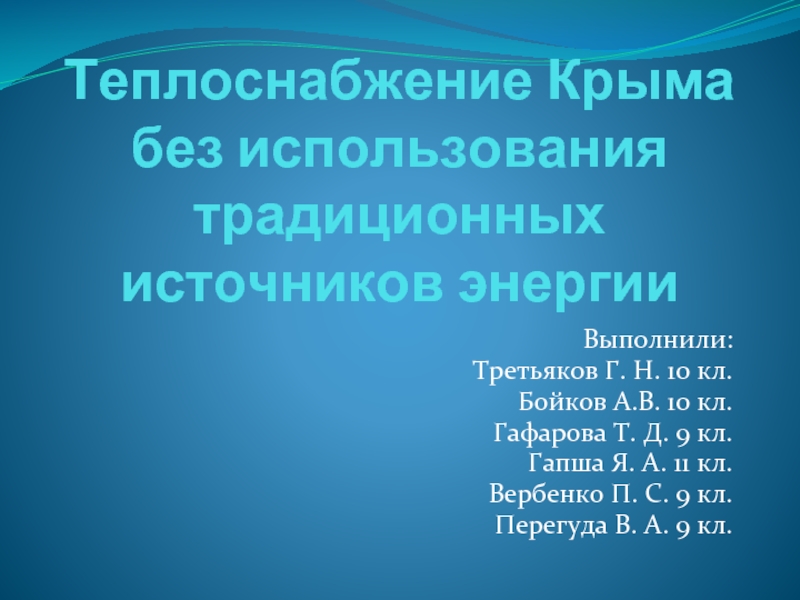- Главная
- Разное
- Дизайн
- Бизнес и предпринимательство
- Аналитика
- Образование
- Развлечения
- Красота и здоровье
- Финансы
- Государство
- Путешествия
- Спорт
- Недвижимость
- Армия
- Графика
- Культурология
- Еда и кулинария
- Лингвистика
- Английский язык
- Астрономия
- Алгебра
- Биология
- География
- Детские презентации
- Информатика
- История
- Литература
- Маркетинг
- Математика
- Медицина
- Менеджмент
- Музыка
- МХК
- Немецкий язык
- ОБЖ
- Обществознание
- Окружающий мир
- Педагогика
- Русский язык
- Технология
- Физика
- Философия
- Химия
- Шаблоны, картинки для презентаций
- Экология
- Экономика
- Юриспруденция
Introduction to macroeconomics (Lecture 1) презентация
Содержание
- 1. Introduction to macroeconomics (Lecture 1)
- 2. "The study of economics does not
- 3. Go ahead then! Do you have any doubts in your capabilities?
- 4. Lecture 1 Introduction to Macroeconomics The
- 5. Macroeconomics is the branch of economics.
- 6. In translation from Greek «micro» means
- 7. Macroeconomics and Microeconomics Macroeconomics analyzes the
- 8. Macroeconomics versus Microeconomics
- 9. Using Microeconomics in Macroeconomics Macroeconomics is based
- 10. Macroeconomics as a Special Discipline But …
- 11. The founder of macroeconomics as a special
- 12. The ХVIII century – beginning of the
- 13. Classical Economists: the Gallery
- 14. Economy consists of two separate sectors: the
- 15. The main economic problem is the scarcity
- 16. But up to the ХХ century macroeconomics
- 17. «Keynesian Revolution» In 1936 a prominent
- 18. The real sector and the money sector
- 19. The central point of Keynes’ theory: the
- 20. Monetarism (Milton Friedman, Edmund Phelps )
- 21. Schools Alternative to Keynesian Approach: the
- 22. Development of Macroeconomics Macroeconomics as a
- 23. The diversity of approaches to the explanation
- 24. ? ? ? ? ? ? ?
- 25. Questions Macroeconomists Try to Answer ? ?
- 26. Overall output - long-run changes – economic
- 27. Why to Learn Macroeconomics?
- 28. Macroeconomic theory reveals and explores the regularities
- 29. Principles of Macroeconomic Analysis Macroeconomics is the
- 30. Exogenous The value of endogenous variable
- 31. Frequently, the endogenous variable is presented as
- 32. Types of Relationship between Variables An economic
- 33. Modeled behavior can be presented by a
- 34. Importance of Using Graphs A graph is
- 35. Types of Visual Data Presentation Pie Diagram
- 36. Intuitive analysis assumes the study and the
- 37. where y – an endogenous (dependent)
- 38. Algebraic and Graphical Analysis: Correlation signs «+»
- 39. Positive and Normative Economics Positive Economic Theory
- 40. This is the basic economic model. It
- 41. B When there is the disequilibrium, and
- 42. Market clearing is an alignment process whereby
- 43. Prices: Flexible versus Sticky Economists typically assume
- 44. Long-run and Short-run Analysis Long-run issues are
- 45. Long-run Growth versus Business Cycle Aggregate Output
- 46. Types of Economic Resources The amount of
- 47. Time Intervals in Macroeconomics Olivier Blanchard
- 48. The main principle of macroeconomic
- 49. Macroeconomic Agents Households the owners of economic
- 50. Macroeconomic Agents Government the producer of public
- 51. Macroeconomic Agents Foreign sector interacts with
- 52. Equilibrium price (PE) Macroeconomic Markets
- 53. Model of Circular Flows We begin with
- 54. Simple (Private Sector) Diagram of Circular
- 55. Private Sector Model
- 56. Private Sector Diagram of Circular
- 58. Expenditures are now divided
- 59. Injection is something that increases the
- 60. The Role of the Government Adding
- 61. Diagram of Circular Flows with Government (Mixed
- 62. The Three-Sector Model of the Economy Now
- 63. Taxes represent the revenues of the government.
- 64. Diagram of Circular Flows with Government
- 65. The Role of the Foreign Sector Now
- 66. Net foreign investment
- 67. In the open economy the expenditure-income identity
- 68. From the injections-leakages identity we can also
- 69. Stock and Flow Variables A flow is
- 70. FLOW STOCK STOCK FLOW
- 72. The Macroeconomic System It is a market
- 73. Macroeconomic Policy Economic Growth Policy
- 74. Aggregate Demand and
Слайд 2
"The study of economics does not seem to require any specialized
John Maynard Keynes
Слайд 4Lecture 1
Introduction to Macroeconomics
The Subject Matter of Macroeconomics
The History of
Key Macroeconomic Issues
Principles of Macroeconomic Analysis
Macroeconomic Agents and Macroeconomic Markets
The Model of Circular Flows
The Macroeconomic System
Слайд 5
Macroeconomics is the branch of economics.
Economics is a discipline which studies
The study of economics is subdivided into two general fields:
What is Macroeconomics?
Economics
Microeconomics
Macroeconomics
Слайд 6In translation from Greek
«micro» means «small»,
For the first time the term “macroeconomics” was used in 1933 by the Norwegian economist-matematician Ragnar Frisch (Nobel prize, 1969) who introduced the concepts of “microeconomic” and “macroeconomic dynamics”.
In 1941 Piet De Wolff divided economic theory into microeconomics and macroeconomics.
The History of the Term «Macroeconomics»
Слайд 7Macroeconomics and Microeconomics
Macroeconomics
analyzes the economy as
studies aggregate economic behavior, i.e. the behavior of aggregate economic agents on aggregate economic markets;
deals with the economic issues that affect the entire economy and most of society;
studies aggregate variables such as gross domestic product, national income, aggregate demand, aggregate supply, general price level, rate of unemployment, public deficit, exchange rate, etc.
Microeconomics
analyzes individual components of the economy;
studies economic behavior of individual units (individual firm or individual household) on markets for particular goods and services (wheat, computers, oil, bicycles, gold, etc.);
deals with the decision-making of a certain firm (a producer) or a certain household (a consumer);
studies such variables as the amount of a firm’s output or of a consumer’s income, quantities demanded and supplied of parti- cular goods and their prices, etc.
Слайд 9Using Microeconomics in Macroeconomics
Macroeconomics is based on microeconomics
Microeconomics
Macroeconomics
At the same time all the decisions of individual agents are made taking into account the macroeconomic situation.
Слайд 10Macroeconomics as a Special Discipline
But …
despite both disciplines use the same
not every statement that is true for an individual is always true for the entire economy (example: the paradox of thrift).
Thus, microeconomics and macroeconomics have specific subjects and methods of analysis and are based on specific approaches and theories. They are even taught as separate disciplines.
Слайд 11 The founder of macroeconomics as a special part
He showed that macroeconomics
has a special subject and some special methods of analysis.
His contribution to economic theory was so large, that it was called the «Keynesian revolution».
The Founder of Macroeconomics
Слайд 12The ХVIII century – beginning of the ХХ century – classical
David Hume «Of the Balance of Trade», 1752 – the analysis of the relation between the money stock, trade balances and the price level; laid the foundation of the quantity theory of money.
The main ideas and concepts of the classical approach were developed in the works of Adam Smith («An Inquiry into the Nature and Causes of the Wealth of Nations», 1776), David Ricardo («On the Principles of Political Economy and Taxation», 1817), Jean-Baptiste Say («Traité d’économie politique ou Simple exposé de la manière dont se forment, se distribuent et se consomment les richesses», 1803; «Cours complet d’économie politique pratique», 1828–1830), William Stanley Jevons («The Theory of Political Economy», 1871), Leon Walras («Elements of Pure Economics», 1874), Alfred Marshall («The Principles of Economics», 1890), John Bates Clark («The Distribution of Wealth», 1899), Arthur Pigou («The Economics of Welfare», 1920).
The History of Macroeconomics
Слайд 14Economy consists of two separate sectors: the real sector and the
There is perfect competition in all the markets ⇒ economic agents cannot influence market prices, they are price-takers.
All the prices are flexible and are set by the relation between supply and demand ⇒ the principle of A.Smith’s «invisible hand» and «market clearing».
Government has no need to intervene in the regulation of the economy ⇒ the principle «laissez faire, laissez passer».
Classical School: Basic Propositions
Слайд 15The main economic problem is the scarcity of resources, which hence
The scarcity of resources poses puts in the forefront the problem of production ⇒ the analysis of economy’s behavior from aggregate supply side («supply-side analysis»).
The «Say’s law» acts in the economy: «supply creates its own demand», because each economic agent is simultaneously a seller and a buyer.
The problem of expanding of production possibilities is resolving slowly, the mutual market adjustment is a long-term process ⇒ the description of economy’s behavior in the long run («long- run analysis»).
Classical School: Basic Propositions
Слайд 16But up to the ХХ century macroeconomics didn’t exist as a
Three events had the fundamental importance for the development of macroeconomics:
the beginning of the collection of economic information and systematization of aggregate data (the period of the I World War) that provided the empirical base for macroeconomic research: 1920-s – the elaboration of the System of National Income and Product Accounts (NIPA) – Simon Kuznets (Nobel prize, 1971) and Richard Stone (Nobel prize, 1984);
the substantiation of the fact that the business cycle is a recurring phenomenon (1920-s – Wesley Clair Mitchell );
the Great Depression (1929–1933) – world economic catastrophe (the Great Crash) that contradicted to the postulates of classical economists about the self-correcting economy.
The History of Macroeconomics
Слайд 17«Keynesian Revolution»
In 1936 a prominent British economist, lord
He criticized the main postulates of the classical school and gave his own explanation of the macroeconomic phenomena.
Macroeconomics became a special discipline, and a new approach appeared in economic analysis.
Слайд 18The real sector and the money sector are related to each
There is imperfect competition in the markets.
Prices (nominal variables) are rigid («sticky»).
Equilibrium in the markets is settled, but not on the full-employment level.
Private sector expenditures are unable to provide the level of aggregate demand required to obtain the potential level of output, and, therefore, government intervention and government regulation is needed.
In the conditions of underemployment of economic resources aggregate demand becomes the main problem of the economy («demand-side analysis»).
Government stabilization policy affects economy in the short run, and price rigidity exists relatively for not long period ⇒ the description of the economy’s behavior in the short run («short-run analysis»).
Keynes’ Approach: Basic Propositions
Слайд 19The central point of Keynes’ theory: the market economy does not
During 25 years after the II World War – the period of fast economic growth in most countries – the belief that government is able to prevent recessions by actively using fiscal and monetary policy.
But in the middle of 1970-x – stagflation (the combination of high inflation with stagnation, i.e. low and even negative rates of economic growth and high unemployment) – the conclusion: the key source of instability is the stabilization policy itself ⇒ «Neoclassical counterrevolution».
The History of Macroeconomics
Слайд 20Monetarism (Milton Friedman, Edmund Phelps )
- the market economy is
- economic fluctuations are the result of the changes in the money stock, therefore, to provide stability the Central bank should maintain the constant money growth rate («monetary rule»);
New Classical Macroeconomics (Robert Lucas, Thomas Sargent, Neil Wallace) (the rational expectations theory)
- if the economic agents’ expectations are rational, government policy is ineffective;
Real Business Cycle Theory (Finn Kydland, Edward Prescott)
- the source of economic disturbances are technological shocks rather than government policy.
Supply-side Economics (Arhur Laffer)
- government policy should be aimed to stimulate aggregate supply rather than aggregate demand.
Schools Alternative to Keynesian Approach
Слайд 21 Schools Alternative to Keynesian Approach: the Gallery
Monetarism
Real Business Cycle Theory
Supply-side
New Classical Macroeconomics
Слайд 22Development of Macroeconomics
Macroeconomics as a science is permanently developing
These changes are the result of the impact of two groups of factors:
The appearance of new theories,
while old theories are rejected as not consistent with economic reality or as outdated in the light of new concepts.
The permanent development of the economy itself, that poses new questions and requires new answers.
Слайд 23The diversity of approaches to the explanation of macroeconomic events and
This diversity of ideas is due to the complexity of macroeconomic problems and allows to examine them comprehensively, thoroughly, and from different points of view.
Diversity of Macroeconomic Theories
Слайд 24?
?
?
?
?
?
?
Why do incomes grow? Would our children live better than we
Why are some countries richer than others? Why do some countries are growing faster than others?
Why recessions and expansions occur in the economy?
Why is there unemployment? Is it a necessary part of economic life? Why unemployment is low in some countries and high in the others?
Why prices grow? What is the cost of inflation for the society?
Is it better for an economy to have budget deficit or budget surplus? trade deficit or trade surplus? to be a lender or a borrower in the world financial markets?
Key Questions Macroeconomists Try to Answer
Слайд 25Questions Macroeconomists Try to Answer
?
?
?
?
?
?
Why interest rates fluctuate? What impact have
What are the determinants of the exchange rates? Is it good to have a strong or a weak domestic currency?
Is government policy able to affect long-term economic growth? Can it eliminate or at least smooth economic fluctuations during the business cycle?
How economic changes in one country effect the situation in others?
Answer: study macroeconomics and be informed!
Слайд 26Overall output
- long-run changes – economic growth
- short run
Unemployment
Inflation
Interest Rates
Government Budget
Balance of Payments and Exchange Rates
Macroeconomic Policy
Key Macroeconomic Issues
Слайд 27Why to Learn Macroeconomics?
Macroeconomists are concerned with issues
for economic health of every nation;
for all economic agent as the base of their decision-making;
to estimate proposals made by politicians and which can have great impact on national and world economy.
The state of the macroeconomy affects:
everyday life and welfare of everyone;
economic activity of every firm;
political sphere, i.e. government policy;
well-being of the whole society;
the peace and stability within the country and in the world.
It is almost impossible in today’s complex world to be a responsible citizen without having some grasp of economic issues and principles.
Слайд 28Macroeconomic theory
reveals and explores the regularities of macroeconomic processes and events;
aims
helps to understand the cause-and-effect relations in the aggregate economy;
serves the base for elaboration of principles, tools and measures of macroeconomic policy that might prevent or improve economic performance and can in the best way serve to the needs of the society;
provides the framework to make forecasts of future economic development, to predict future economic problems.
Macroeconomics represents a fascinating intellectual occupation that has
great practical importance.
The Importance of Macroeconomics
Слайд 29Principles of Macroeconomic Analysis
Macroeconomics is the social science and the controlled
Economic model is a stylized representation of the economy, a generalization and abstraction of reality that seeks to isolate a few of the most important determinants (causes) of an economic event in order to provide a better understanding of that event.
Economic models are constructed and used
to simplify the analysis of complex economic reality;
to examine the relationship between economic phenomena and the regularity of their development;
to understand what goes on in the economy and how the economy works;
to develop policies that might prevent, correct, or alleviate economic problems and improve the situation in the economy;
to forecast future development of economic process.
Слайд 30 Exogenous
The value of endogenous variable depends and is determined by
Endogenous
Macroeconomic Models
To study the most important elements that explain how the whole economy works, economic models are based on assumptions, which cut off details unimportant for the analysis of a certain economic process or phenomenon and reduce the complexity of economic behavior.
Once modeled, economic behavior may be presented as a relationship between a dependent (endogenous) variable and a few independent (exogenous) variables.
MODEL
Exogenous (independent) variable
is the one whose value is determined by forces outside the model.
Endogenous (dependent) variable is those whose value is determined within the model.
Слайд 31Frequently, the endogenous variable is presented as depending upon only one
Models should be simple and focused on the examination of the phenomenon or process under study. They do not need to be «realistic», but should be consistent with the facts.
There must be the possibility of the transition from one model to the other depending on the context.
There can be no one grand «true» model that exactly and completely describes the economic reality.
The Rules of Model Construction
Слайд 32Types of Relationship between Variables
An economic model specifies whether the dependent
The relationship between variables is positive when the dependent variable moves in the same direction as the independent variable.
The relationship is negative when the value of the dependent variable increases (decreases) when the value of the independent variable decreases (increases).
Example: positive relation of consumption spending from income.
Example: negative relation of investment spending from the interest rate.
Models which specify economic reality provide the framework for organizing data, empirically testing economic hypotheses, and forecasting economic behavior.
Слайд 33Modeled behavior can be presented by a function, an equation, a
Model Presentations
a table
Слайд 34Importance of Using Graphs
A graph is a way of:
visual presentation
visual demonstration of ideas and theories, which are less clear and even may be misinterpreted or misunderstood, when are only verbally explained;
visual illustration of models proposed by economists.
In the course of economics graphs are used for the
better perception of theoretical propositions by students.
«Graphs are plotted by economists
to confuse students».
A student joke
Слайд 35Types of Visual Data Presentation
Pie Diagram
Bar Diagram
Time Series Graph
Scatter Graph
Consumption
spending on
food goods – 33,8%
Consumption
spending on
nonfood goods – 38,6%
Consumption
spending on
services – 27,6%
Interest rate (r)
Investment (I)
I(r)
Investment Demand Curve
Structure of Consumption Spending, Russia, 2012
GDP Growth Rate in Selected Countries
Слайд 36Intuitive analysis assumes the study and the explanation of the mechanism
Types of Analysis
Economic analysis is the combination of:
functional (algebraic) analysis;
graphical (visual) analysis;
intuitive (substantial verbal) analysis.
In our course of macroeconomics the intuitive analysis (intuition) will be of primary importance, because the main goal of the economist is not simply to declare relations between macroeconomic phenomena, but first of all and what is more – to explain its economic sense.
Слайд 37where
y – an endogenous (dependent) variable, which is plotted on
x – an exogenous (independent) variable, which is plotted on the other axis of the scatter graph, i.e. it is a cause or a determinant; its change leads to the movement along the line;
a – an autonomous variable, which incorporates all the other variables that affect an endogenous variable, and which can be represented as a point of intersection of the line with the axis; its change results in the parallel shift of the line;
For simplicity sake in our analysis we will use the assumption about linear relationship between variables that can be represented by the following equations:
y = a + bx or y = a – bx
Algebraic and Graphical Analysis: Correlation
Слайд 38Algebraic and Graphical Analysis: Correlation
signs «+» or «–» characterize the type
b – the sensitivity (the extent of reaction) of the endogenous variable to the change of the exogenous variable, measured as the tangent of the angle ; its change results in the change of the slope of the line.
Слайд 39Positive and Normative Economics
Positive Economic Theory
is the objective or scientific
reflects facts and studies actual economic performance;
is an explanation why the economy works as it does;
is a basis for predicting how the economy will respond to changes in circumstances;
free from subjective value judgments;
represents an approach of a scientist.
Normative Economic Theory
involves subjective value judgments about what economy must be or what measure is to be undertaken on the base of a particular economic concept or theory;
makes prescriptions what should be done in the economy;
offers recommendations for chan-ges in economic policy to achieve an optimal and desirable state of affairs;
is based on personal (subjective) value judgments;
represents an approach of a politician.
Слайд 40This is the basic economic model. It describes the ubiquitous relationship
The Model of Supply and Demand
Equilibrium:
Quantity Demanded = Quantity Supply
E
Equilibrium
price (PE)
Equilibrium quantity (QE)
Слайд 41B
When there is the disequilibrium, and the price is equal either
C
E
PE
QE
Shortage
Surplus
A
D
Under the price P1, the quantity supplied exceeds the quantity demanded = excess supply (= a surplus = AB) ⇒ the price will fall to the equilibrium price PE.
Under the price P2, the quantity demanded exceeds the quantity supplied = excess demand (= a shortage = CD) ⇒ the price will rise to the equilibrium price PE
P1
P2
The process is called market clearing.
How Market Equilibrium is Reached
Слайд 42Market clearing is an alignment process whereby decisions between
Suppose a sudden increase in demand ⇒ excess demand places a upward pressure on the price from point A to point B since the original price Р1 no longer clears the market.
Market Clearing
S
D1
S1
D
А
D2
P1
P2
Shortage
А
В
В
S2
Surplus
P1
P2
Q1
Q2
Q1
Q2
Suppose a sudden increase in supply ⇒ excess supply, on the contrary, places a downward pressure on the price and the new equilibrium price will be Р2.
In both cases market clears by itself.
Price (P)
Price (P)
Quantity (Q)
Quantity (Q)
Слайд 43Prices: Flexible versus Sticky
Economists typically assume that the market will go
But, assuming that markets clear continuously is not realistic. For markets to clear continuously, prices would have to adjust instantly to changes in supply and demand, i.e. must be fully flexible.
But, evidence suggests that prices and wages often adjust slowly and in actuality, some of them are sticky.
The difference between macroeconomic theories is primarily based on the assumption of how quickly the prices change and thus how quickly all the markets clear.
.
Слайд 44Long-run and Short-run Analysis
Long-run issues are analyzed under the assumption of
Short-run issues are analyzed under the assumption of rigid (or sticky) prices. The level of output is mainly determined by the aggregate expenditures in the economy (or aggregate demand). Such level is called actual output. Its changes are associated with the business cycle.
Time factor is of great importance in macroeconomics.
Macroeconomists usually distinguish the short-run and the long-run behavior of aggregate economy.
Слайд 45Long-run Growth versus Business Cycle
Aggregate Output
Time (years)
Economic Growth (potential output)
Business
Слайд 46Types of Economic Resources
The amount of output that can be produced
Labor: the physical and mental effort of people. This can be increased by education, training and experience (human capital);
Physical capital: the stock of manmade equipment (like machinery, tools, vehicles, computers) and structures (buildings, constructions, real estate) that are used to produce goods and services;
Land or Natural resources: inputs provided by nature, such as land, rivers, mineral deposits, oil and gas reserves. They come in two forms: renewable and non-renewable.
Entrepreneurial ability: the ability to identify opportunities and organize production (that is the effort and know-how to put the other resources together in a productive venture), and the willingness to accept risk in the pursuit of rewards.
Слайд 47Time Intervals in Macroeconomics
Olivier Blanchard in his textbook distinguishes
According to these time intervals the accent is put on the study of different macroeconomic problems, and the analysis is based on different models.
Слайд 48 The main principle of macroeconomic analysis is aggregation.
Aggregation
The subject matter of macroeconomics is to study aggregate economic behavior, i.e. behavior of aggregate (macroeconomic) agents on aggregate (macroeconomic) markets.
There are four macroeconomic agents and four macroeconomic markets.
Слайд 49Macroeconomic Agents
Households
the owners of economic resources (suppliers of factors of production);
the
the main consumers of goods and services (demanders for aggregate output);
the main savers (lenders).
Firms
the main producers of goods and services (suppliers of aggregate output);
the main demanders for economic resources;
the consumers of the part of aggregate output (demanders for investment goods);
the main borrowers.
Households and firms form the private sector of the economy.
Слайд 50Macroeconomic Agents
Government
the producer of public goods;
the consumer of the part of
(purchaser of goods and services);
the redistributor of national income (through collecting taxes and making transfer payments);
lender or borrower in the financial markets (depending on the state of government budget);
the regulator of economic activity:
- establishes and supports institutional basis for the economic performance (“rules of the game”);
- conducts macroeconomic policy.
Private and government sectors form
the closed economy
(or the mixed closed economy), that is
the economy not interacting with other economies.
Слайд 51Macroeconomic Agents
Foreign sector
interacts with the national economy through two channels:
international trade
exchange of goods and services
capital flows
exchange of assets,
primarily financial (bonds and shares)
Economy that interacts with other economies (with the rest of the world) is called
the open economy
Слайд 52Equilibrium
price (PE)
Macroeconomic Markets
Equilibrium quantity (QE)
E
Goods (or
Resource (or factor) market
Financial market
which consists of two segments:
money market
bonds market
Foreign exchange market
Слайд 53Model of Circular Flows
We begin with the simple or private or
In order to understand how the aggregate economy works and to analyze the aggregate economic behavior economists use the model of circular flows, that represents
the interaction between macroeconomic agents through macroeconomic markets.
Слайд 54Simple (Private Sector) Diagram of
Circular Flows
Goods Market
Households
Flow of money
Flow of goods and services and of economic resources
Revenues
Expenditures
Goods and Services Purchased
Goods and
Services Sold
Factor Payments (Wages, Rents,
Interest, Profits)
Incomes
Inputs (Factor Services)
Land, Labor, Capital, Entrepreneurship
Resource Market
Слайд 55
Private Sector Model
Goods flow from firms to households through the goods (product) market and economic resources flow from households to firms through the resource (factor) market.
Firms pay factor incomes (wages, rent, interest and profits) to households - the owners of economic resources and households spend their incomes buying goods and services. Hence,
aggregate income is equal to aggregate expenditures
(all income is spent, all expenditures translate in somebody’s income);
aggregate expenditures are equal to aggregate product
aggregate product is equal to aggregate income.
Movement of income, expenditures and product form a circle.
Thus, we have circular flows.
Слайд 56 Private Sector Diagram of Circular
Goods Market (Y)
Households
Firms
Resource Market
Revenues
Consumption
Spending (C)
Incomes (Y)
Financial Market
Saving (S)
Loanable
Funds (F)
Investment
Spending (I)
Factor Payments (Wages, Rents,
Interest, Profits)
Слайд 57
a deposit in a bank,
a purchase of a security (an equity or a bond), issued by firms.
Saving of households are used by firms to buy investment (or capital) goods (equipment and structures), necessary to maintain and to expand the level of output.
Spending, made by firms for the purchase of investment goods, are called investment spending. To obtain funds, firms take loans from the banks or issue and sell securities to households.
Financial markets connect saving and investment.
The Role of Financial Markets
Being rational, households spend only part of their income, the rest they save, because saving can bring extra income, if money is used in the financial markets in the form of:
Слайд 58
Expenditures are now divided into two parts:
- consumption spending
- investment spending of firms (I).
AE = C + I
Income is also divided into two parts:
- consumption spending (C);
- saving (S).
Y = C + S
Expenditures and Income in the Private Sector Model
Слайд 59Injection is something
that increases the flow of spending and leads
Leakage is something
that withdraws from the flow of spending and can cause the decrease in output and income
Private Sector Model of
Circular Flows with Financial Market
The equalities between aggregate expenditures (AE) and aggregate income (Y), and between aggregate income and aggregate product are still held:
Investment is an injection, saving is a leakage.
AE ≡ Y
or
C + I ≡ C + S
thus
I ≡ S
It means that injections are equal to leakages.
Слайд 60The Role of the Government
Adding government to our analysis, we
The influence of the government sector is executed through:
Purchases of goods and services (G)
which include:
goods purchased to run government and the military;
payments to govern-ment employees and the military for their personal services.
Transfers to households (Tr) & subsidies to firms (Sb)
which are government payments that involve no direct service by the recipient. Transfers include:
unemployment insurance payments;
welfare payments to households.
In addition to transfers persons receive interest on public debt (i × BGov).
Taxes (Tx)
which are imposed
upon property and income (direct taxes);
upon goods and services (indirect taxes, such as VAT, sales and excise taxes)
in order to pay for all the expenditures of the government.
Слайд 61Diagram of Circular Flows with Government
(Mixed Closed Economy)
Goods
Households
Firms
Resource Market
Consumption
Spending (C)
Incomes (Y)
Factor Payments (Wages, Rents,
Interest, Profits)
Saving (S)
Loanable Funds (F)
Investment
Spending (I)
Government
Revenues
Government Purchases (G)
Loan to the Government
(if G + Tr > Tx)
Taxes (Tx)
Subsidies (Sb)
Transfers (Tr)
Taxes (Tx)
Financial Market
Слайд 62The Three-Sector Model of the Economy
Now the sum of aggregate expenditures
AE = C + I + G
and aggregate income
Y = C + S + Tx – Tr
We get two injections – G and Tr and a leakage – Tx:
AE ≡ Y ⇒ C + I + G ≡ C + S + Tx – Tr
⇒ I + G + Tr ≡ S + Tx
With the appearance of the government sector aggregate income, earned by households, (national income Y) differs from the income that they can use for consumption and saving (disposable income YD):
YD = Y – Tx + Tr
YD = C + S
Слайд 63Taxes represent the revenues of the government. Government purchases of goods
The balance between the government revenues and expenditures is called government (or public) budget.
If revenues exceed expenditures (Tx > G + Tr), there is budget surplus.
If they are equal (Tx = G + Tr), the budget is balanced.
If expenditures exceed revenues (Tx < G + Tr), government runs budget deficit.
To finance budget deficit government either takes a loan (borrows funds) from financial market, issuing and selling government bonds to the public or prints money.
If there is budget surplus, government is a saver. The excess of government revenues over government expenditures is called public (or government) saving (SG):
SG = Tx – (G + Tr)
Government Budget
Слайд 64Diagram of Circular Flows with Government
Goods Market (Y)
Households
Firms
Resource Market
Consumption
Spending (C)
Incomes (Y)
Factor Payments (Wages, Rents,
Interest, Profits)
Saving (S)
Loanable Funds (F)
Investment
Spending (I)
Government
Revenues
Foreign Sector
Exports (Ex)
Imports (Im)
Government Purchases (G)
Loan to the Government
(if G + Tr > Tx)
Taxes (Tx)
Subsidies (Sb)
Transfers (Tr)
Taxes (Tx)
Capital Inflow (if Im > Ex)
Financial Market
Слайд 65The Role of the Foreign Sector
Now aggregate product
This equation is known as the national accounts identity
Difference between exports and imports is called net exports (NX) NX = Ex – Im
and represents country’s trade balance.
The country can have trade surplus (Ex > Im)
or trade deficit (Im > Ex).
In the case of trade surplus the country is a saver (a lender) and there is capital outflow.
In the case of trade deficit the country is a borrower and there is capital inflow: foreign sector saving (SF) move to the country’s economy. SF = Im – Ex
Adding foreign sector, we get new flows. A country exports domestic goods and services (Ex) and imports foreign-made goods and services (Im).
Слайд 66 Net foreign investment = the purchase of
= capital outflow – capital inflow.
When a domestic resident
buys and controls capital in a foreign country, it is known as foreign direct investment;
buys stock in a foreign corporation, but has no direct control of the company, it is known as foreign portfolio investment.
Net foreign investment (NFI) always equals net exports (NX):
NFI = NX or –NFI = –NX
When net exports is positive (Ex – Im > 0), net foreign investment is positive (= net capital outflow).
When net exports is negative (Ex – Im < 0), net foreign investment is negative as well (= net capital inflow).
Net Foreign Investment
Слайд 67In the open economy the expenditure-income identity is
C + I +
As now we get an extra injection (Ex) and an extra leakage (Im), then the injections-leakages identity will be
I + G + Tr + Ex ≡ S + Tх + Im
Total investment are identically equal to the sum of total saving:
I ≡ S + (Tx – G – Tr) + (Im – Ex)
Private
Saving
Government (Public) Saving
Foreign Sector Saving
National Saving
The Four-Sector Model: Important Identities
This last equation is called the capital formation equation.
Слайд 68From the injections-leakages identity we can also get
uses-of-private-saving identity:
budget deficit financing identity:
(G + Tr – Tx) ≡ S – (I + NX)
Financing of Domestic Investment
Financing of Budget Deficit
Loan to the Foreign Sector
Government Budget Deficit
Loan from the Foreign Sector
Private Sector Saving
Fall in Domestic Investment
The Four-Sector Model: Important Identities
Слайд 69Stock and Flow Variables
A flow is an economic magnitude measured per
All the variables in the model of circular flows (output, income, consumption, saving, investment, taxes, budget deficit, trade surplus and others) are flows.
A stock is an economic magnitude measured at a particular point of time (on November 1st , 2015).
Examples: wealth, savings, government debt, capital stock, money supply, number of unemployed, etc.
Macroeconomic variables can be divided into stocks and flows.
Flows add to or diminish stocks.
For example, the flow of investment changes the stock of capital; the flow of budget deficit increases the stock of government debt; the flow of saving affects the stock of wealth.
Слайд 71
P
Y
LRAS
SRAS
SRAS
AD
The Image of the Macroeconomic System
External Factors
Objectives
Instruments
Market Economy
Слайд 72The Macroeconomic System
It is a market economy which
is influenced by external
natural (weather, earthquakes, spots on the sun, tsunami, eruptions, etc);
social (revolutions, wars, overturns, etc)
has objectives (induced variables):
economic growth;
high employment;
stable prices;
balance of payments equilibrium.
use instruments (policy variables):
fiscal policy;
monetary policy;
income policy;
foreign trade and exchange rate policy.
Macroeconomic Policy
Слайд 73Macroeconomic Policy
Economic Growth Policy
Stabilization Policy
is aimed to stimulate
growth in the long run and to
affect productive possibilities
of the economy;
suggests changes primarily
in aggregate supply.
is aimed to smooth out business
cycle in the short run and to
diminish the depth of recessions
and the height of booms;
suggests changes primarily
in aggregate demand.
Слайд 74
Aggregate Demand and Aggregate Supply
Consumption
Investment
Government Spending
Net
Equilibrium General Price Level
Cost of Human Resources
Cost of Capital Resources
Cost of Natural Resources
Technology
Equilibrium Aggregate Output
P
Y
P
Y*
SRAS
SRAS
LRAS
Y
AD
Market Economy: the Key Concepts
Aggregate Supply
Aggregate Demand

